
Want to create or adapt books like this? Learn more about how Pressbooks supports open publishing practices.

3 Ethical Decision Making
Learning Objectives
The purpose of this chapter is to:
- 1) Outline the decision making process
- 2) Explain the nature of ethical decision making
- 3) Provide ethical frameworks used in making decision making
Decision Making
This chapter introduces us to the concept of ethical decision making. To properly contextualize our understanding of ethical decision making, perhaps it would be prudent to separate the two elements – decision making in general, and then ethics. Managers make thousands of decisions every day. In most cases they intuit the decision making process and can come to the best solution within nanoseconds of hearing about a problem. These are the types of problems that are routine, and have low consequences. However, the big decisions that managers have to regularly make require more due diligence, forethought, and collaborative effort with colleagues. These problems portend serious consequences, and in many cases organization performance depends on good decision making. Hannaway (1989) found that managers are in a constant state of making decisions as “[they] switch frequently from task to task, changing their focus of attention to respond to issues as they arise, and engaging in a large volume of tasks of short duration” (p. 39).
Decision making is the action or process of thinking through possible options and selecting one (Bright et. al, 2019). A rudimentary framework for how managers engage in the decision making process contains four steps.
- 1) Identify the problem
- 2) Generate alternatives
- 3) Decide on a course of action
- 4) Implement
There are several ways that a manager can use this framework to make decisions – intuition, analysis, democratic process, etc. However, they all contain the same elements of problem identification and then evaluating alternatives before deciding on a course of action. The intuitive decision maker simply “knows” what the problem and alternatives are before acting. A manager using analytical tools might uncover new insights from trying to really figure out what the problem is. A democratic manager will rely on the use of the team to work through understanding the problem and figuring out alternative courses of action.

Identify the Problem
The first challenge in decision making is working to understand what the problem is. Ineffective managers focus on the symptoms without identifying the underlying issues. A child with a runny nose does not have a runny nose problem, she has an infectious disease causing a running nose. The implication here is simple; if we treat symptoms, the problem will re-create the symptoms if given enough time. For the child, let’s say we stuff endless Kleenex up her nose. This won’t address the virus creating this symptom and others (temperature, cough, etc.) In a similar way, a firm might have a turnover issue and put resources towards paying people more, improving conditions, or added benefits. However, without truly understanding the cause of the turnover, these resources are wasted. The turnover in this scenario is being caused by an unbearable manager that makes life miserable for employees. No amount of pay raise or work condition changes will keep someone around for very long when abuse like this is happening.
A college freshman turns his paper in to the professor during the first week of class. A week later the professor calls the student into her office and states simply “You got a D on the paper, but I have good news. You don’t have a writing problem.” The student is confounded, and asks the professor to explain. “You don’t in fact have a writing problem, you have a reading problem. You write like you speak, which tells me that you do not read very much. I recommend that you read more. Anything you want, just read – Men’s Health, your textbook, Dostoevsky, and this will make you a better writer. You will naturally imitate what you are seeing.” A good manager tries to understand what is causing the symptoms. First step is to identify the real problem.
Generate Alternatives
Problems come in different scopes and magnitude. In some cases they are routine, like a manager putting together a shift schedule for the week. The problem identification is simply a matter of understanding that personal preferences and personal obligations will conflict as he tries to schedule shifts. This problem does not require the manager to generate a wide list of alternatives. It might include negotiation, allowing workers to swap shifts, or simply making a schedule and forcing employees to deal with it. However, there are bigger problems that require a manager to generate a long and comprehensive list of alternatives. When problems have intense consequences, or the context is an unknown one to the organization, a wide list of alternatives is necessary. The future is unknown, and the problem is unlike one you’ve ever seen. This is the time to brainstorm, get creative, and generate alternatives.
Consider a company dealing with the aftermath of a mass shooting incident. Consider a fast food restaurant trying to remain solvent during a national pandemic that requires consumers to remain at home. Consider a company in New Mexico who screens job applicants for drug use, and they are taking job applicants from Colorado where marijuana use is legal. Consider an airplane manufacturer who lost consecutive contract bids and has to cut expenses somewhere. Each of these problems are serious that require managers to generate a wide list of alternatives.
If we encounter a problem we have seen before, we don’t need to stray too far to find viable alternatives. However, when we face a new problem in an unknown context, we need a wide range of alternatives. Here’s a simple illustration. Consider the following three questions:
Provide a range of outcomes (low and high estimates) for the following questions:
How many US Presidents have resided in the White House?
What is the population of Reykjavik?
How many Sasquatches per square mile reside in the Pacific Northwest?
If you have any frame of references for these questions, your range of outcomes will probably be narrow. If you have no idea, you need to answer the question with a wide range. Most of us have a general idea that the number of total US Presidents is somewhere in the forties, and perhaps we can recall from a high school American History class that the British burned the White House during the War of 1812, which was probably four to five presidencies in, and the White House has existed at least since then. This means we can estimate that the range is 35-45 presidents have lived there (The first was John Adams, making the correct answer 44). Reykjavik is in Iceland, and if you knew that you also know it has a small population, and the city probably does not crack the world’s top 100 most-populated cities. It sort of feels like an Cheyenne, Wyoming or a Madison, Wisconsin – enough to be a capital city, but not enough to make headlines regularly. We might give this a wider range because we are not quite sure – 50,000 to 500,000 residents. The population of Reykjavik, Iceland is 125,000. Finally, those dang sasquatches. If you have a solid frame of reference, I would like to hear it, or maybe the government has already talked to you. . . . but alas most of us have only theories and speculation (like if there really were sasquatches, don’t you think your Uncle Howard who lives in Western Oregon would have shot one by now?) We should give this question a VERY wide range of estimates. Let’s use 0 to 1,000. This is an unknown, with no frame of reference.
These three questions get progressively farther from any frame of reference you have, which requires you to expand your range of outcomes. This exercise illustrates the point that if we have a frame of reference, we don’t have to stray too far. If we are in unchartered waters, we need to widen our thinking. The same holds true for problems and generating alternatives. We need to take the time to think through all available options, and maybe even do something we never thought possible, or has ever been done before.
Decide and Implement
Once we have generated a list of alternatives, we need a way to decide which of the alternatives should be pursued. Again, managers can use intuition, analysis, or democracy to achieve this. However, a common approach is the employment of a cost benefit analysis . The cost-benefit analysis is a process by which managers evaluate a course of action based on the anticipated positive and negative effects an alternative will generate. In financial analysis the calculations can be quite complicated, but once you have an output the decision is easy – choose the project with the highest rate of return or net present value. However, when making decisions that are more difficult to quantify, a cost benefit analysis becomes more challenging. The costs can include any form of utility – capital expenditures, employee morale, loss of human life, a decrease in customer service, environmental pollution, violation of the law. The benefits are equally difficult to gauge and in many cases – revenues, company culture, respect to human dignity, customer rapport, environment stewardship, and avoidance of fines. Once the cost benefit analysis is conducted, the decision becomes clear, and this is the third step in the decision making process.
A example of this cost benefit analysis – Tara, the regional sales manager has to decide whether terminating her best salesman is in the best interest of the company. Braden is the top performer by far in the organization. However, he treats the accounting team with disdain, the logistics team hates him, and he sometimes engages in deliberately insubordinate behavior. Keeping him around would bolster sales figures for the foreseeable future, but the company will slowly leak some good talent away as Braden’s coworkers find a place to work with better workplace culture. Firing Braden comes with the benefits of retained talent in support services, improved morale, and a clear precedent for future salesmen, that this behavior won’t be allowed. The cost benefit analysis results in a decision to terminate, and to eat the costs of training a new hire, and working for a few months to get sales figures back up.
Once the alternatives are evaluated and one (or more) are selected, implementing the course of action requires the manager to put resources towards that choice. This could mean signing a check, empowering an employee to take on responsibility, or in the example above, calling William into the office to communicate a decision has been made.
Ethical Dilemmas
Most decisions that managers make during the day are routine and do not involve the need to reflect on the ethics of the situation. However, the steps in the decision making framework need to be followed especially stringently in the situations where ethical implications loom. This begs the question – which situations present ethical dilemmas to managers?
Before we answer that question, let’s borrow some thinking from the Ancient Greeks. Socrates posed the question – “If we between us, have a heap of sand, consisting of millions of grains, and suppose I remove one grain, shall it no longer be a heap?” This question then follows, “supposing no, shall I remove two grains so that it no longer becomes a heap?” This logic follows until only one grain remains, at which point we would no longer consider the heap of sand a heap. However, is there a point between one and a million, that we can identify the heap as something other than a heap? Socrates termed this a “Sordite’s Paradox.” That is, a minor change in the condition of existence does not change the existence, but a series of consecutive minor changes would change its existence. How does this apply to ethical dilemmas?
Ethical dilemmas are situations that present various courses of moral action, none of which are clearly acceptable or preferable. This means that the ethical solution is not clear, yet a choice needs to be made. Under this definition we need to exclude decisions like cheating a customer, lying to the shareholders, polluting rivers, embezzling, money laundering, ignoring unsafe conditions, putting the public at risk, insurance fraud, extortion, bribery, copyright violations, and the long list of other white-collar crimes. These are not ethical dilemmas. These are ethical choices whereby we choose to do right or the wrong. The difference between these and ethical dilemmas is that the choice in a dilemma is not always clear. Let’s go back to Socrates to explore this.
Socrates tells us that at one point the sand heap is a heap, and at some point the heap becomes something less than a heap. There exists a gray area within the change, a point that determines whether or not it’s a heap, but that point is unclear. If you look at Figure 2.1, at which point (A, B, or C) does the sand no longer represent a heap.
Figure 3.1 – A Sordite’s Paradox

Let’s apply this to an ethical dilemma (remember, it’s a decision with a gray area and the choice is not always clear). If a business has any sort of operational component – how much to spend on employee safety can be considered an ethical dilemma. There is a wide range of expenditure options here. The company generates revenue presumably and can spend anywhere from 0% of those revenues on safety (equipment, training, compliance expenditures) all the way to 100% of their corporate revenues. As we think about the craziness of either alternative, we have just entered into the Sordite’s Paradox. We intuitively know that spending $0 on safety is unethical because it puts lives and livelihoods at risk. We violate the dignity of our workers by doing this. Well, then we ask the question, what about 1% of company revenues on safety? Still not there? What about 2%? If we take this logic all the way to 100% we would have safe working conditions with compliance rules in place, protective equipment, appropriate training, and what would be a waste of resources on anything that is not needed (you can only spend so much on training before it becomes ineffective). Workers would spend more time training than working, and we would have cumbersome and unnecessary procedures that slow production. In the 100% scenario though, there is a bigger issue – we are violating the financial obligation to shareholders of the company by not working on their behalf to improve profitability in our roles as managers. Somewhere between 0% and 100% we passed the right number to spend on safety that optimizes both safety and still allows the business to make money. 0% violates our ethics towards employee safety, and 100% violates our ethic towards shareholder obligations. The right answer lies somewhere in the gray area, and it is here that we encounter our ethical dilemma.
Figure 3.2 – An Ethical Dilemma Regarding Safety Expenditures

A final note on ethical decision making is that we generally don’t start with the extremes in ethical decision making. We naturally jump right into the middle of the gray area because we know the extremes and the fringes of the gray area are not worth pursuing. It is in the gray area that we must navigate, using ethical decision making to figure out the best solution. We can achieve good decision making using ethical frameworks.
Is the Law Enough?
Before we get to the ethical frameworks you can use to navigate ethical decision making, we need to address a common question, is the law enough to guide us in our ethics? The short answer is that the law is an insufficient means to regulate our ethical decision making. There are two primary reasons for this. First, the law gives us bare minimums in terms of safety, human dignity, and respect of rights. However, most ethical dilemmas are navigated well above these elements. For example, we are required to provide appropriate safety equipment and make sure employees have safety certifications they need. But this does not constitute the entirety of our ethical obligations in terms of safety. What is the right decision in keeping a grocery store open in a pending hurricane? OSHA has no regulation on that. Yet, we are putting our employees at risk. H-E-B (grocery chain in Texas) in Houston asked for volunteers and paid employees overtime to keep stores open so area residents. This decision went well beyond the safety minimums the law requires for a grocery store. Another example is that managers are required to respect the terms of a contract. However, the integrity of a company can be severely challenged if the focus is entirely on compliance. For example, during the 2008 financial crisis, many fertilizer manufacturers held contracts that customers bought at the top of the market. The contracts their customers entered into obliged them to pay what would become three times the market price after the crash. However, many manufacturers worked with their customers and renegotiated the contracts to make the customers competitive in the marketplace. This was well beyond the minimum legal requirements of the contracts. Minimum wage indicates the bare minimum your workers need to be compensated, however, this does not always equate to a living wage

in many metropolitan areas. Each of these examples highlight the need to navigate the ethical dilemmas we face with something more than the law.
The seco nd reason why the law is not a good standard is that sometimes we put in place some really bad laws. Consider the United States Eugenics movement in the early 1900s. We put in place laws that allowed for the forced sterilization of 60,000 Americans that the government determined were unworthy of reproduction. This included alcoholics, criminals, intellectually disabled, and many more categorizations. Only in hindsight sometimes do we see the errors of the laws we have put on the books.
Ethical Frameworks
Because the law is insufficient, and the nature of ethical dilemmas is one of navigating ambiguity, we need to establish frameworks that will help us make decisions. The following ethical frameworks are intended to do that. Moral relativism offers a local solution to making ethical decisions. Utilitarianism focuses on maximizing the greatest good for the most number of people. Justice view emphasizes the relationship between members of the organization. Corporate social responsibility encourages consideration for all stakeholders affected by the decision making of an organization. By using these frameworks as a guide, we can begin to work through a reasonable solution to ethical questions that do not have a glaring, obvious solution. These frameworks give us structure in the gray area. Each has benefits, and faults, but they are at least a starting point for establishing ethical thinking.
Moral Relativism
The construct of moral relativism holds that ethical values and judgements are ultimately dependent upon one’s culture, society, or personal feelings (DesJardin, 2011). Under this framework, the right answer to the ethical dilemma will change based on who is analyzing the ethical problem. Moral relativism makes the ethical decision making simple, in that the local perspective should guide the reasoning. If a manager is making a decision that is based in China, the Chinese standards of ethics should apply. If a manager is making a decision in South Carolina, as opposed to Alaska, the South Carolina worldview would trump the decision making.
There is an important distinction that needs to be made when discussing the idea of moral relativism. That is, there is a significant difference, a giant chasm in fact, between relative truth and objective truth. An example of a relative truth is something like that of an opinion – who is the greatest between LeBron James, Michael Jordan, and Kobe Bryant. One could make the case for each of these and come to three different opinions. If I stand up and say that MJ is the best, this is a relative truth. This is my opinion and not true for everyone analyzing the same decision. Mint Oreo is the best ice cream flavor. Oh, you disagree? Under the construct of relative truths that is ok. Moral relativism works perfectly fine under these conditions. Examples of this would be in Colombian culture, its ok to show up to social gatherings a tad (I mean a lot sometimes) bit late. Colombians expect this. In Iowan culture, the expectation is that if a meeting or party is scheduled for 3pm, you should show up on time, lest you offend the host. Moral relativism is an acceptable practice for cultural norms such as these. However, when it comes to evaluating serious ethical problems, there are some inherent challenges with this framework. This is sometimes called cultural relativism, and when dealing with issues of relative truths, is a common business practice.
In stark contrast to truths that change, the objective truths never change. Objective truths can also not contradict each other, otherwise one of them would be false, rendering it not objectively true. Here’s an example: In The Hobbit (one of the best books of all time, my relative truth), Bilbo finds the ring in the cave where Gollum is hiding. Bilbo engages in a battle of riddles with Gollum, and eventually wins the intellectual battle by asking Gollum “what’s in my pocket?” (Spoiler alert) It’s the ring. At this point we can with certainty determine that there cannot be a ring in Bilbo’s pocket, and simultaneously be nothing in his pocket. One of those is true. They cannot both be true. The existence or absence of a ring is an objective truth. This is a metaphysical example showing that objective truths cannot contradict themselves. In the same way, if I say “there is a God” and an atheist says “no there is not,” there is only one thing we can agree on and that is, only one of us can be right.
Let’s bring this distinction to the ethical framework of moral relativism. When discussing matters of ethics and the human condition, objectives truths indeed exist (as illustrated with the God example). In the same way we should state “Human dignity should never be violated” or “human dignity should be compromised in some situations.” Both of those cannot be true. This means that moral relativism can contradict itself. If something is objectively true in one culture, it cannot be objectively untrue in another culture. In these situations, moral relativism would be useless as a framework for decision making.
Moral relativism has one final, fatal flaw. The major premise that moral relativism touts is that “no absolute truth exists.” Logically, this would be that any truth that we claim cannot be absolute, meaning it can only be a relative truth. However, the premise upon which moral relativism stands is itself an absolute truth. Therefore, the statement “there is no absolute truth” cannot be true, meaning that absolute truth must exist.
This question has been debated for millennia from the Romans, to the Middle Age debaters responding to Thomas Aquina’s Summa Theologie, to your high school civics teacher preparing the debate squad for a Saturday meet. Exploring it and unpacking it all here is beyond the scope of this book. Moral relativism is seriously handicapped from the aforescribed self-defeating premises. However, identifying it and illustrating the fatal inherent flaws is an important task when studying ethics because iterations and camouflaged versions of this framework are still used in modern business practice.
A final note on moral relativism – in addition to the logical fallacy that it presents, there is an inherent danger in using this as an ethical framework. If all ethical decisions are left up to the local perspective, then even atrocious practices must be tolerated. This means that we cannot condemn anything that presents a prima facie case of unethical practice. We would be unable to condemn child labor, female genital mutilation, genocide, sex trafficking, Ponzi schemes, and the litany of other wicked practices that are accepted in some cultures.
Utilitarianism
Utilitarian ethics focuses on maximizing the greatest good for the most number of people. Originally espoused by the English philosopher, John Steward Mill, this ethical framework provides us with a formula upon which to base our decisions. Ethical decisions should be based on the perceived outcomes they will lead to, and alternatives evaluated based on whether they will maximize the good from the greatest number of people. Good can be defined in several ways. Good can equate to generation of money, satisfaction, life, health, opportunity, utility, and anything that is reasonable attributed to improving the human condition. By default, this also means that utility maximization also avoids loss of good (loss of life, loss of money, etc.) Once the choices are evaluated and the estimated outcomes are determined, the ethical choice is the one that creates the most benefit.
Utilitarianism makes ethical decision making easy once the outcomes have been projected. Will this project potentially harm the local water source? What will that cost in terms of clean up or quality of life? Will building a factory create jobs? After asking a series of questions like this, the outcomes are estimated to total impact or good, however that is defined in your ethical dilemma. However, this ethical framework has two primary limitations. First, the concept of utility (or good) is not always easily defined. Financial analysts can project income and net present values of decisions, and these decisions are easy to make once the numbers are in. But how do you estimate how much satisfaction something will bring? If a decision is going to result in the loss of life, how much is a human life worth? How do you estimate the impact a decision has on the community’s culture? Determining utility and then calculating is easy in some cases, but in most it becomes a major challenge to using this framework. The second challenge for utilitarianism is that maximizing the greatest good for most, might result in the sacrifice of a few. A classic example of utilitarianism is the layoff decision. We need to lay off thirty people so that the company stays solvent, and continues to provide jobs for the remaining seventy people. In this case the company stays solvent, but the thirty workers now struggle to provide for their families. Another example is a mass casualty incident. If a trauma ward is overrun with cases, the lead doctor must make decisions about which patients receive immediate care and which ones must be put aside. In this situation, the doctor is trying to save the most human life, which might result in patients with less serious injuries have to wait hours in pain to be treated.

Justice View
The justice view of ethics is one that endeavors to treat everyone fairly and impartially. A basic notion of justice is that we should give people what they are due. People are owed respect, dignity, civility, equity, and humanity for example. If we are trying to decide a path forward in an ethical dilemma, we would focus on these principles to decide which is the right path forward. If we make a decision that violates these principles, then justice has been violated, and we should consider alternatives. The justice view as an ethical framework can be further dissected into four specific forms – distributive justice, interpersonal justice, procedural justice, and commutative justice.
Distributive justice emphasizes equality when allocating resources. This means that individuals are given a fair opportunity to acquire resources. Resources can include salary, opportunities for promotion, benefits, favorable shifts, location preferences, and the like. To avoid violating distributive justice, managers should not discriminate against individuals for the inherent characteristics which would include demographic makeup like race, age, sex, and all of the other categorizations that make up protected classes in the workplace. However, we must also avoid giving preference to the best friend, the family member, the direct report who constantly flatters the manager, the person who attended the same university as the manager, and any other characteristic outside actual performance of an individual. If, however, an individual has earned privilege through their performance, it is completely justified to provide additional resources. The top performing salesman should receive a bonus. The accountant who continually catches errors should get preferential treatment for time off during tax season. The logistics scheduler who builds meaningful rapport with dispatchers should be promotion. In each of these cases, the individual has earned the right to the resource, and distributive justice has not been violated. If we as managers have some sort of preferred method for doling resources other than what people have earned through their performance, we are violating distributive justice.
Interpersonal justice an ethical framework that focuses on the communication within a relationship. The essence of this justice view is that the manner in which we communicate determines whether or not justice has been violated. Talking to people with disrespect, belittling, coercing, or being rude or uncivil in a delivery of a message all constitute interpersonal justice violations. Consider the following two scenarios. Scenario #1: Brook has continually underperformed to the point where the manager has determined that she should be terminated. The manager sits down with Brook and calmly explains the consequences of her performance, wishes her well, and on the way out the door offers a reference to her for a job opportunity. Brook is not happy about losing her job, but she does not feel like interpersonal justice has been violated. Scenario #2: Otto works as a cost accountant and recently performed above his peers during a factory expansion project. As a result, the accounting manager has rewarded him with two tickets to the Milwaukee Brewers game. As the manager hands Otto the tickets he says, “I know that if accountants don’t get out of the office, they will whine about it, so here are two tickets.” In this scenario, Otto earned the prize so distributive justice was not violated. However, the way the manager treated him makes him feel disrespected, a clear violation of interpersonal justice.
We have this unstated expectation that we should be treated with dignity. This is why any form of sexual harassment immediately elicits an indignant response. It violates the interpersonal justice view that we should not be talked to, or treated in a way counter to decency and our humanity. When we are treated with disrespect in the workplace we resent the manager or the organization in that moment, and if this happens often enough, research shows that it will affect our own performance, and the performance of the organization (Estes & Wang, 2008). In short, avoid disrespecting people and you will maintain interpersonal justice.
Procedural justice follows that as long as the protocols and rules are followed, procedural justice has not been violated. If the organization gives out promotions based on how long someone has been at the organization, and this is a clearly established rule, procedural justice would not be violated within this context. It might be the case that we disagree with this rule because being at an organization a long time does not make you good at something (like tenure at a university, high school teachers, military promotions), but as long as it is an established rule, no one will feel that procedural justice has been violated. Another example of procedural justice is the manner in which people are evaluated for their work. At a customer service call center, companies often evaluate their employees based on a set of standard metrics. Everyone knows them, there are clocks on the wall to measure them, and at the end of the evaluation period, everyone knows what to expect. These include metrics like how long calls last, did the agent resolve the issue, and did the customer have to call back later to ask more questions. Again, some of these are measures that could be improved, and we might disagree with them, but the rules are being followed and so procedural justice wins. Consider the example of a professor who has established a rubric for the midterm paper. It has been posted on the Blackboard site, and it was communicated well before the assignment was due. The students work on the paper, submit them, and receive an evaluation that falls outside the rubric metrics. The professor had not included spelling and grammar as part of the rubric, but during the grading of the papers, he hammers the students on this point. The students will feel that procedural justice has been violated because the rules (in this case an established rubric) were not followed. Under procedural justice, what the rules are do not matter. Whether they were followed do matter.

The good news here is that the law is on your side. It would be unlawful for someone to include terms within a contract that the other party was unaware of. Additionally, the language within the contract has to be written in a way that a reasonable person can understand it. In the absence of these factors, the court has upheld that some terms within contracts are not enforceable. These clauses violate commutative justice because we have a right to know what we are agreeing to.
Corporate Social Responsibility
Finally, an ethical framework that has gained in popularity in the last two decades is corporate social responsibility (CSR). CSR is an ethical framework that takes into consideration all of the stakeholders that are impacted by a business decision. This means that in addition to considering the financial stake that shareholders have in an organization, the employees, communities, creditors, suppliers, environment, and government should also be included in the consideration of decision making. Klein (2012) states that “every corporation has an overarching social purpose that transcends the operations of corporate social responsibility and, when well understood and effectively integrated, can have profound business and social results” (para 4). The underlying premise with CSR is that business need to do more than simply make money. They need to advance the agenda of the social good as well. Other names for this approach include the triple bottom line and balanced scorecard, whereby companies report on their impact on profit, planet and people (Spreckley, 1981).
Let’s go back to the outsourcing example. If we consider this decision a gray area ethical dilemma, we can use CSR to consider how to move forward. An analysis might these questions: What is the profitability of outsourcing our production (shareholders)? How much should we pay in severance to domestic workers (employees)? What is the economic impact on local town where factory will close (community)? What economic benefit will the factory in the new country bring to its local community? Are we violating any U.S. laws with our labor practices in the new country (government)? What is the impact on our supply chain and vendors (suppliers)? And the list goes on. CSR as an ethical framework forces companies to think through all stakeholder groups as they make decisions. What should be clear as a downside to this ethical framework is that sometimes stakeholders have competing interests. Your decision to move abroad helps the new town, but hurts the old. It has profitability potential, but might require you to use a new supplier or creditor, forcing them to find new business. This is the main criticism with CSR, but the overall idea with this framework is that we need to at least be asking the questions about each group as we make decisions.
The origins of CSR come from a classic view of business that profits come first. In the 1970s, Milton Friedman famously stated that businesses have only one purpose and that was to maximize wealth for the owners. He offered that by taking care of owners, they would by default be taking care of society by virtue of providing jobs for employees, who would then be providing economic growth for society, etc. In the 1980s, this idea was challenged by Edward Freeman, who established stakeholder theory – the founding idea for what we call CSR today. Since then many businesses have gone beyond simply focusing on profits and have established clear missions on creating social value
CSR has been the focus major corporations and researchers alike over the last two decades. Much of this emphasis has been placed on a related concept of sustainability , which entails the responsible and efficient use of the earth’s natural resources. Sustainability in recent years has also expanded to enscope social and economic variables as well – treating each of the resources in these domains as resources that require attention, diligence, and consideration.
Critical Thinking Questions
Which element of the decision making process is the most important to get right? Why?
Which ethical framework makes the most sense? Why?
Why is the law not a sufficient standard to use as our ethical guide?
How to Answer the Critical Thinking Questions
For each of these answers you should provide three elements.
- General Answer. Give a general response to what the question is asking, or make your argument to what the question is asking.
- Outside Resource. Provide a quotation from a source outside of this textbook. This can be an academic article, news story, or popular press. This should be something that supports your argument. Use the sandwich technique explained below and cite your source in APA in text and then a list of full text citations at the end of the homework assignment of all three sources used.
- Personal Story. Provide a personal story that illustrates the point as well. This should be a personal experience you had, and not a hypothetical. Talk about a time from your personal, professional, family, or school life. Use the sandwich technique for this as well, which is explained below.
Use the sandwich technique:
For the outside resource and the personal story you should use the sandwich technique. Good writing is not just about how to include these materials, but about how to make them flow into what you are saying and really support your argument. The sandwich technique allows us to do that. It goes like this:
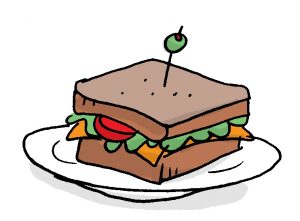
Step 1: Provide a sentence that sets up your outside resource by answering who, what, when, or where this source is referring to.
Step 2: Provide the quoted material or story.
Step 3: Tell the reader why this is relevant to the argument you are making.
Chapter References
J., O’Rourke, J., Parboteeah, P., Pierce, J., Reece, M., Shah, A., Terjesen, S., Weiss, White, M. (2019). Principles of Management . Rice University, Open Stax: Houston, TX
DeJardin, J. (2011). An introduction to business ethics (4th ed). New York, NY: McGraw Hill.
Estes, B., & Wang, J. (2008). Integrative literature review: Workplace incivility: impacts on
individual and organizational performance. Human Resource Development Review, 7 (2), 218-240
Hannaway, J. (1989). Managers Managing: The Workings of an Administrative System. New
York: Oxford University Press, P. 39
Klein, P. (2012). Defining the social purpose of business. Forbes Online. Retrieved
from https://www.forbes.com/sites/csr/2012/05/14/defining-the-social-purposeof- business/#14e2188b1cac.
Lussier, R. (2021). Management Fundamentals: Concepts, Applications, Skill Development. (9th
Ed). Sage Publications: Thousand Oaks, CA.
Nourse, V. (2016). When eugenics became law: Victoria Nourse reviews a study on a
historic US misuse of biology, the case of Buck V. Bell. Nature, 530(7591)
Spreckley. F. 1981. Social Audit: A Management Tool for Co-operative Working. Leeds, UK:
Beechwood College.
The Four Functions of Management Copyright © 2020 by Dr. Robert Lloyd and Dr. Wayne Aho is licensed under a Creative Commons Attribution-NonCommercial 4.0 International License , except where otherwise noted.
Share This Book
Writing Ethical Papers: Top Tips to Ace Your Assignment
17 August, 2021
13 minutes read
Author: Kate Smith
Writing a complex essay paper can be a tough task for any student, especially for those who do not have their skills developed well or do not have enough time for lengthy assignments. At the same time, the majority of college students need to keep their grades high to maintain their right to receive merit-based scholarships and continue their studies the next year. To help you with your ethical papers writing, we created this guide. Below, you will find out what an ethical paper is, how to structure it and write it efficiently.
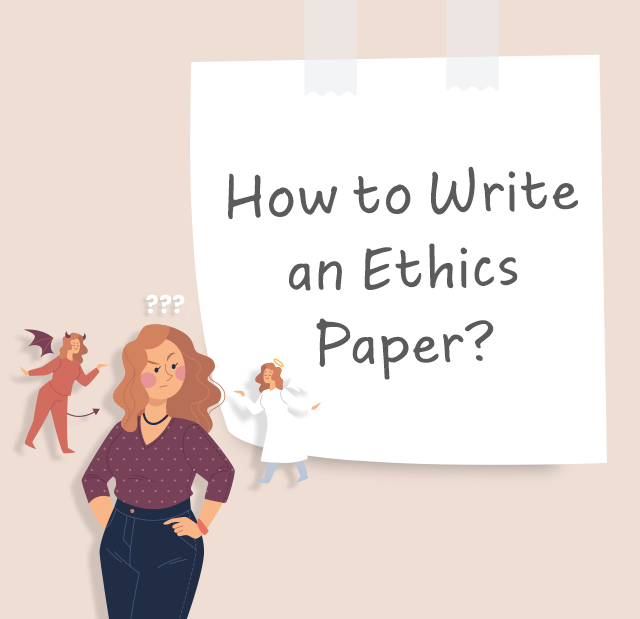
What is an Ethical Paper?
An ethics paper is a type of an argumentative assignment that deals with a certain ethical problem that a student has to describe and solve. Also, it can be an essay where a certain controversial event or concept is elaborated through an ethical lens (e.g. moral rules and principles), or a certain ethical dilemma is explained. Since ethics is connected to moral concepts and choices, a student needs to have a fair knowledge of philosophy and get ready to answer questions related to relationships, justice, professional and social duties, the origin of good and evil, etc., to write a quality paper. Also, writing an ethics paper implies that a student should process a great amount of information regarding their topic and analyze it according to paper terms.
General Aspects of Writing an Ethics Paper
Understanding the ethical papers’ features.
Every essay has differences and features that make it unique. Writing ethical papers implies that a student will use their knowledge of morality and philosophy to resolve a certain ethical dilemma or solve a situation. It can also be a paper in which a student needs to provide their reasoning on ethical or legal circumstances that follow a social issue. Finally, it can be an assignment in which an ethical concept and its application are described. On the contrary, a history essay deals with events that took place somewhen earlier, while a narrative essay is a paper where students demonstrate their storytelling skills, etc.
Defining What Type of Essay Should Be Written
Most of the time, ethical paper topics imply that a student will write an argumentative essay; however, ethics essays can also be descriptive and expository. Each of these essay types has different guidelines for writing, so be sure you know them before you start writing your papers on ethics. In case you missed this step in your ethical paper preparation stage, you would end up writing a paper that misses many important points.
Studying the Ethical Paper Guidelines
Once you get your ethical paper assignment, look through the guidelines that your instructor provided to you. If you receive them during the class, don’t hesitate to pose any questions immediately to remove any misunderstanding before writing an ethics paper outline, or ask for references that you need to use. When you are about to write your first draft, don’t rush: read the paper instructions once again to make sure you understand what is needed from you.
Paying Attention to the Paper Topic
The next thing you need to pay attention to is the ethical paper topic: once you are given one, make sure it falls into the scope of your educational course. After that, consider what additional knowledge may be needed to elaborate on your topic and think about what courses of your program could be helpful for it. Once you are done, read through your topic again to recheck whether you understand your assignment right.
Understanding the Notions of Ethical Arguments, Ethical and Legal Implications, and Ethical Dilemma
Last but not least, another important factor is that a student has to understand the basic terms of the assignment to write a high-quality paper. Ethical arguments are a set of moral rules that are used to defend your position on an ethical issue stated in your essay topic. We refer to ethical versus legal implications when we think about the compensation for certain ethical dilemma outcomes and whether it should be a moral punishment or legal judgment. An ethical dilemma itself refers to a problem or situation which makes an individual doubt what position to take: e.g, abortion, bribery, corruption, etc.
Writing Outline and Structure of an Ethics Paper
Every essay has a structure that makes it a solid piece of writing with straight reasoning and argumentation, and an ethics paper is not an exclusion. This paper has an introduction, body paragraphs, and conclusion. Below, we will describe how each part of ethical papers should be organized and what information they should contain.
First comes the introduction. It is the opening part of your paper which helps a reader to get familiar with your topic and understand what your paper will be about. Therefore, it should contain some information on your ethics paper topics and a thesis statement, which is a central statement of your paper.
The essay body is the most substantive part of your essay where all the reasoning and arguments should be presented. Each paragraph should contain an argument that supports or contradicts your thesis statement and pieces of evidence to support your position. Pick at least three arguments to make your position clear in your essay, and then your paper will be considered well-structured.
The third part of an ethics paper outline is a conclusion, which is a finishing essay part. Its goal is to wrap up the whole essay and make the author’s position clear for the last time. The thoughtful formulation in this essay part should be especially clear and concise to demonstrate the writer’s ability to make conclusions and persuade readers.
Also, don’t forget to include the works cited page after your writing. It should mention all the reference materials that you used in your paper in the order of appearance or in the alphabetical one. This page should be formatted according to the assigned formatting style. Most often, the most frequently used format for ethical papers is APA.
20 Examples of Ethical Paper Topics
- Are there any issues in the 21st century that we can consider immoral and why?
- What is corporate ethics?
- Why is being selfish no longer an issue in 2023?
- Euthanasia: pros and cons
- Marijuana legalization: should it be allowed all over the world?
- Is abortion an ethical issue nowadays?
- Can we invent a universal religion appropriate for all?
- Is the church necessary to pray to God?
- Can we forgive infidelity and should we do it?
- How to react if you are witnessing high school bullying?
- What are the ways to respond to a family abusing individual?
- How to demand your privacy protection in a digital world?
- The history of the American ethical thought
- Can war be ethical and what should the conflicting sides do to make it possible?
- Ethical issues of keeping a zoo in 2023
- Who is in charge of controlling the world’s population?
- How to achieve equality in the world’s rich and poor gap?
- Is science ethical?
- How ethical is genetic engineering?
- Why many countries refuse to go back to carrying out the death penalty?
Ethical Papers Examples
If you still have no idea about how to write an ethics paper, looking through other students’ successful examples is always a good idea. Below, you can find a relevant ethics paper example that you can skim through and see how to build your reasoning and argumentation in your own paper.
https://www.currentschoolnews.com/education-news/ethics-essay-examples/
https://sites.psu.edu/academy/2014/11/18/essay-2-personal-ethics-and-decision-making/
Ethical Papers Writing Tips
Choose a topic that falls into the ethics course program.
In case you were not given the ethics paper topic, consider choosing it yourself. To do that, brainstorm the ethical issues that fascinate you enough to do research. List all these issues on a paper sheet and then cross out those that are too broad or require expertise that you don’t have. The next step you need to take is to choose three or four ethical topics for papers from the list and try to do a quick search online to find out whether these topics are elaborated enough to find sources and reference materials on them. Last, choose one topic that you like the most and find the most relevant one in terms of available data for reference.
Do your research
Once the topic is chosen and organized, dive deeper into it to find the most credible, reliable, and trusted service. Use your university library, online scientific journals, documentaries, and other sources to get the information from. Remember to take notes while working with every new piece of reference material to not forget the ideas that you will base your argumentation on.
Follow the guidelines for a paper outline
During the preparation for your ethical paper and the process of writing it, remember to follow your professor’s instructions (e.g. font, size, spacing, citation style, etc.). If you neglect them, your grade for the paper will decrease significantly.
Write the essay body first
Do not rush to start writing your ethics papers from the very beginning; to write a good essay, you need to have your outline and thesis statement first. Then, go to writing body paragraphs to demonstrate your expertise on the issue you are writing about. Remember that one supporting idea should be covered in one paragraph and should be followed by the piece of evidence that confirms it.
Make sure your introduction and conclusion translate the same message
After your essay body is done, write a conclusion and an introduction for your paper. The main tip regarding these ethics paper parts is that you should make them interrelated: your conclusion has to restate your introduction but not repeat it. Also, a conclusion should wrap up your writing and make it credible for the audience.
Add citations
Every top-quality paper has the works cited page and citations to demonstrate that the research on the topic has been carried out. Therefore, do not omit this point when formatting your paper: add all the sources to the works cited page and pay attention to citing throughout the text. The latter should be done according to the formatting style indicated in your instructions.
Edit your paper
Last but not least is the editing and proofreading stage that you need to carry out before you submit your paper to your instructor. Consider keeping your first draft away from sight for a day or two to have a rest, and then go back to check it for errors and redundant phrases. Don’t rush to change anything immediately after finishing your writing since you are already tired and less focused, so some mistakes may be missed.
Writing Help by Handmadewriting
If you feel that you need help with writing an ethics paper in view of its chellnging nature, you can contact us and send an order through a respective button. You can add your paper details by following all steps of the order placing process that you will find on the website. Once your order is placed, we will get back to you as soon as possible. You will be able to contact your essay writer and let them know all your wishes regarding your ethical paper.
Our writers have expertise in writing ethical papers including, so you don’t need to worry about the quality of the essay that you will receive. Your assignment will be delivered on time and at a reasonable price. Note that urgent papers will cost slightly more than assignments with a postponed deadline, so do not wait too long to make your order. We will be glad to assist you with your writing and guarantee 24/7 support until you receive your paper.
Lastly, remember that no paper can be written overnight, so if you intend to complete your paper in a few hours, you can end up writing only a first draft with imperfections. If you have only half a day before your task is due, feel free to place an urgent order, and we will deliver it in just three hours.

A life lesson in Romeo and Juliet taught by death
Due to human nature, we draw conclusions only when life gives us a lesson since the experience of others is not so effective and powerful. Therefore, when analyzing and sorting out common problems we face, we may trace a parallel with well-known book characters or real historical figures. Moreover, we often compare our situations with […]

Ethical Research Paper Topics
Writing a research paper on ethics is not an easy task, especially if you do not possess excellent writing skills and do not like to contemplate controversial questions. But an ethics course is obligatory in all higher education institutions, and students have to look for a way out and be creative. When you find an […]

Art Research Paper Topics
Students obtaining degrees in fine art and art & design programs most commonly need to write a paper on art topics. However, this subject is becoming more popular in educational institutions for expanding students’ horizons. Thus, both groups of receivers of education: those who are into arts and those who only get acquainted with art […]
An official website of the United States government
The .gov means it's official. Federal government websites often end in .gov or .mil. Before sharing sensitive information, make sure you're on a federal government site.
The site is secure. The https:// ensures that you are connecting to the official website and that any information you provide is encrypted and transmitted securely.
- Publications
- Account settings
- Browse Titles
NCBI Bookshelf. A service of the National Library of Medicine, National Institutes of Health.
Open Resources for Nursing (Open RN); Ernstmeyer K, Christman E, editors. Nursing Management and Professional Concepts [Internet]. Eau Claire (WI): Chippewa Valley Technical College; 2022.

Nursing Management and Professional Concepts [Internet].
- About Open RN
Chapter 6 – Ethical Practice
6.1. ethical practice introduction, learning objectives.
• Recognize ethical dilemmas and take appropriate action
• Practice in a manner consistent with a code of ethics for nurses
• Compare and contrast theories of ethical decision-making
• Examine resources to resolve ethical dilemmas
• Examine competent practice within the legal/ethical/regulatory framework of health care
• Defend the course of action or give a rationale for the action
• Apply the ANA Code of Ethics to diverse situations in health care
• Analyze the impact of cultural diversity in ethical decision-making
• Identify advocacy as part of the nursing role when responding to ethical dilemmas
The nursing profession is guided by a code of ethics. As you practice nursing, how will you determine “right” from “wrong” actions? What is the difference between morality, values, and ethical principles? What additional considerations impact your ethical decision-making? What are ethical dilemmas and how should nurses participate in resolving them? This chapter answers these questions by reviewing concepts related to ethical nursing practice and describing how nurses can resolve ethical dilemmas. By the end of this chapter, you will be able to describe how to make ethical decisions using the Code of Ethics established by the American Nurses Association.
6.2. BASIC ETHICAL CONCEPTS
The American Nurses Association (ANA) defines morality as “personal values, character, or conduct of individuals or groups within communities and societies,” whereas ethics is the formal study of morality from a wide range of perspectives.[ 1 ] Ethical behavior is considered to be such an important aspect of nursing the ANA has designated Ethics as the first Standard of Professional Performance. The ANA Standards of Professional Performance are “authoritative statements of the actions and behaviors that all registered nurses, regardless of role, population, specialty, and setting, are expected to perform competently.” See the following box for the competencies associated with the ANA Ethics Standard of Professional Performance[ 2 ]:
Competencies of ANA’s Ethics Standard of Professional Performance[ 3 ]
• Uses the Code of Ethics for Nurses with Interpretive Statements as a moral foundation to guide nursing practice and decision-making.
• Demonstrates that every person is worthy of nursing care through the provision of respectful, person-centered, compassionate care, regardless of personal history or characteristics (Beneficence).
• Advocates for health care consumer perspectives, preferences, and rights to informed decision-making and self-determination (Respect for autonomy).
• Demonstrates a primary commitment to the recipients of nursing and health care services in all settings and situations (Fidelity).
• Maintains therapeutic relationships and professional boundaries.
• Safeguards sensitive information within ethical, legal, and regulatory parameters (Nonmaleficence).
• Identifies ethics resources within the practice setting to assist and collaborate in addressing ethical issues.
• Integrates principles of social justice in all aspects of nursing practice (Justice).
• Refines ethical competence through continued professional education and personal self-development activities.
• Depicts one’s professional nursing identity through demonstrated values and ethics, knowledge, leadership, and professional comportment.
• Engages in self-care and self-reflection practices to support and preserve personal health, well-being, and integrity.
• Contributes to the establishment and maintenance of an ethical environment that is conducive to safe, quality health care.
• Collaborates with other health professionals and the public to protect human rights, promote health diplomacy, enhance cultural sensitivity and congruence, and reduce health disparities.
• Represents the nursing perspective in clinic, institutional, community, or professional association ethics discussions.
Reflective Questions
1. What Ethics competencies have you already demonstrated during your nursing education?
2. What Ethics competencies are you most interested in mastering?
3. What questions do you have about the ANA’s Ethics competencies?
The ANA’s Code of Ethics for Nurses with Interpretive Statements is an ethical standard that guides nursing practice and ethical decision-making.[ 4 ] This section will review several basic ethical concepts related to the ANA’s Ethics Standard of Professional Performance, such as values, morals, ethical theories, ethical principles, and the ANA Code of Ethics for Nurses .
Values are individual beliefs that motivate people to act one way or another and serve as guides for behavior considered “right” and “wrong.” People tend to adopt the values with which they were raised and believe those values are “right” because they are the values of their culture. Some personal values are considered sacred and moral imperatives based on an individual’s religious beliefs.[ 5 ] See Figure 6.1 [ 6 ] for an image depicting choosing right from wrong actions.
In addition to personal values, organizations also establish values. The American Nurses Association (ANA) Professional Nursing Model states that nursing is based on values such as caring, compassion, presence, trustworthiness, diversity, acceptance, and accountability. These values emerge from nursing practice beliefs, such as the importance of relationships, service, respect, willingness to bear witness, self-determination, and the pursuit of health.[ 7 ] As a result of these traditional values and beliefs by nurses, Americans have ranked nursing as the most ethical and honest profession in Gallup polls since 1999, with the exception of 2001, when firefighters earned the honor after the attacks on September 11.[ 8 ]
The National League of Nursing (NLN) has also established four core values for nursing education: caring, integrity, diversity, and excellence[ 9 ]:
- Caring: Promoting health, healing, and hope in response to the human condition.
- Integrity: Respecting the dignity and moral wholeness of every person without conditions or limitations.
- Diversity: Affirming the uniqueness of and differences among persons, ideas, values, and ethnicities.
- Excellence: Cocreating and implementing transformative strategies with daring ingenuity.
View the McCombs School of Business Values video on YouTube. [ 10 ]
Morals are the prevailing standards of behavior of a society that enable people to live cooperatively in groups. “Moral” refers to what societies sanction as right and acceptable. Most people tend to act morally and follow societal guidelines, and most laws are based on the morals of a society. Morality often requires that people sacrifice their own short-term interests for the benefit of society. People or entities that are indifferent to right and wrong are considered “amoral,” while those who do evil acts are considered “immoral.”[ 11 ]
Ethical Theories
There are two major types of ethical theories that guide values and moral behavior referred to as deontology and consequentialism.
Deontology is an ethical theory based on rules that distinguish right from wrong. See Figure 6.2 [ 12 ] for a word cloud illustration of deontology. Deontology is based on the word deon that refers to “duty.” It is associated with philosopher Immanuel Kant. Kant believed that ethical actions follow universal moral laws, such as, “Don’t lie. Don’t steal. Don’t cheat.”[ 13 ] Deontology is simple to apply because it just requires people to follow the rules and do their duty. It doesn’t require weighing the costs and benefits of a situation, thus avoiding subjectivity and uncertainty.[ 14 ],[ 15 ],[ 16 ]
The nurse-patient relationship is deontological in nature because it is based on the ethical principles of beneficence and maleficence that drive clinicians to “do good” and “avoid harm.”[ 17 ] Ethical principles will be discussed further in this chapter.
View the McCombs School of Business Deontology video on YouTube. [ 18 ]
Consequentialism is an ethical theory used to determine whether or not an action is right by the consequences of the action. See Figure 6.3 [ 19 ] for an illustration of weighing the consequences of an action in consequentialism. For example, most people agree that lying is wrong, but if telling a lie would help save a person’s life, consequentialism says it’s the right thing to do. One type of consequentialism is utilitarianism. Utilitarianism determines whether or not actions are right based on their consequences with the standard being achieving the greatest good for the greatest number of people.[ 20 ],[ 21 ],[ 22 ] For this reason, utilitarianism tends to be society-centered. When applying utilitarian ethics to health care resources, money, time, and clinician energy are considered finite resources that should be appropriately allocated to achieve the best health care for society.[ 23 ]
Consequentialism
Utilitarianism can be complicated when accounting for values such as justice and individual rights. For example, assume a hospital has four patients whose lives depend upon receiving four organ transplant surgeries for a heart, lung, kidney, and liver. If a healthy person without health insurance or family support experiences a life-threatening accident and is considered brain dead but is kept alive on life-sustaining equipment in the ICU, the utilitarian framework might suggest the organs be harvested to save four lives at the expense of one life.[ 24 ] This action could arguably produce the greatest good for the greatest number of people, but the deontological approach could argue this action would be unethical because it does not follow the rule of “do no harm.”
Watch McCombs School of Business Consequentialism video on YouTube. [ 25 ] Read more about Decision making on organ donation: The dilemmas of relatives of potential brain dead donors.
Interestingly, deontological and utilitarian approaches to ethical issues may result in the same outcome, but the rationale for the outcome or decision is different because it is focused on duty (deontologic) versus consequences (utilitarian).
Societies and cultures have unique ethical frameworks that may be based upon either deontological or consequentialist ethical theory. Culturally-derived deontological rules may apply to ethical issues in health care. For example, a traditional Chinese philosophy based on Confucianism results in a culturally-acceptable practice of family members (rather than the client) receiving information from health care providers about life-threatening medical conditions and making treatment decisions. As a result, cancer diagnoses and end-of-life treatment options may not be disclosed to the client in an effort to alleviate the suffering that may arise from knowledge of their diagnosis. In this manner, a client’s family and the health care provider may ethically prioritize a client’s psychological well-being over their autonomy and self-determination.[ 26 ] However, in the United States, this ethical decision may conflict with HIPAA Privacy Rules and the ethical principle of patient autonomy. As a result, a nurse providing patient care in this type of situation may experience an ethical dilemma. Ethical dilemmas are further discussed in the “ Ethical Dilemmas ” section of this chapter.
See Table 6.2 comparing common ethical issues in health care viewed through the lens of deontological and consequential ethical frameworks.
Ethical Issues Through the Lens of Deontological or Consequential Ethical Frameworks
View in own window
Ethical Principles and Obligations
Ethical principles are used to define nurses’ moral duties and aid in ethical analysis and decision-making.[ 27 ] Although there are many ethical principles that guide nursing practice, foundational ethical principles include autonomy (self-determination), beneficence (do good), nonmaleficence (do no harm), justice (fairness), fidelity (keep promises), and veracity (tell the truth).
The ethical principle of autonomy recognizes each individual’s right to self-determination and decision-making based on their unique values, beliefs, and preferences. See Figure 6.4 [ 28 ] for an illustration of autonomy. The American Nurses Association (ANA) defines autonomy as the “capacity to determine one’s own actions through independent choice, including demonstration of competence.”[ 29 ] The nurse’s primary ethical obligation is client autonomy.[ 30 ] Based on autonomy, clients have the right to refuse nursing care and medical treatment. An example of autonomy in health care is advance directives. Advance directives allow clients to specify health care decisions if they become incapacitated and unable to do so.
Autonomy and Self-Determination
Read more about advance directives and determining capacity and competency in the “ Legal Implications ” chapter.
NURSES AS ADVOCATES: SUPPORTING AUTONOMY
Nurses have a responsibility to act in the interest of those under their care, referred to as advocacy. The American Nurses Association (ANA) defines advocacy as “the act or process of pleading for, supporting, or recommending a cause or course of action. Advocacy may be for persons (whether an individual, group, population, or society) or for an issue, such as potable water or global health.”[ 31 ] See Figure 6.5 [ 32 ] for an illustration of advocacy.
Advocacy includes providing education regarding client rights, supporting autonomy and self-determination, and advocating for client preferences to health care team members and family members. Nurses do not make decisions for clients, but instead support them in making their own informed choices. At the core of making informed decisions is knowledge. Nurses serve an integral role in patient education. Clarifying unclear information, translating medical terminology, and making referrals to other health care team members (within their scope of practice) ensures that clients have the information needed to make treatment decisions aligned with their personal values.
At times, nurses may find themselves in a position of supporting a client’s decision they do not agree with and would not make for themselves or for the people they love. However, self-determination is a human right that honors the dignity and well-being of individuals. The nursing profession, rooted in caring relationships, demands that nurses have nonjudgmental attitudes and reflect “unconditional positive regard” for every client. Nurses must suspend personal judgement and beliefs when advocating for their clients’ preferences and decision-making.[ 33 ]
Beneficence
Beneficence is defined by the ANA as “the bioethical principle of benefiting others by preventing harm, removing harmful conditions, or affirmatively acting to benefit another or others, often going beyond what is required by law.”[ 34 ] See Figure 6.6 [ 35 ] for an illustration of beneficence. Put simply, beneficence is acting for the good and welfare of others, guided by compassion. An example of beneficence in daily nursing care is when a nurse sits with a dying patient and holds their hand to provide presence.
Nursing advocacy extends beyond direct patient care to advocating for beneficence in communities. Vulnerable populations such as children, older adults, cultural minorities, and the homeless often benefit from nurse advocacy in promoting health equity. Cultural humility is a humble and respectful attitude towards individuals of other cultures and an approach to learning about other cultures as a lifelong goal and process.[ 36 ] Nurses, the largest segment of the health care community, have a powerful voice when addressing community beneficence issues, such as health disparities and social determinants of health, and can serve as the conduit for advocating for change.
Nonmaleficence
Nonmaleficence is defined by the ANA as “the bioethical principle that specifies a duty to do no harm and balances avoidable harm with benefits of good achieved.”[ 37 ] An example of doing no harm in nursing practice is reflected by nurses checking medication rights three times before administering medications. In this manner, medication errors can be avoided, and the duty to do no harm is met. Another example of nonmaleficence is when a nurse assists a client with a serious, life-threatening condition to participate in decision-making regarding their treatment plan. By balancing the potential harm with potential benefits of various treatment options, while also considering quality of life and comfort, the client can effectively make decisions based on their values and preferences.
Justice is defined by the ANA as “a moral obligation to act on the basis of equality and equity and a standard linked to fairness for all in society.”[ 38 ] The principle of justice requires health care to be provided in a fair and equitable way. Nurses provide quality care for all individuals with the same level of fairness despite many characteristics, such as the individual’s financial status, culture, religion, gender, or sexual orientation. Nurses have a social contract to “provide compassionate care that addresses the individual’s needs for protection, advocacy, empowerment, optimization of health, prevention of illness and injury, alleviation of suffering, comfort, and well-being.”[ 39 ] An example of a nurse using the principle of justice in daily nursing practice is effective prioritization based on client needs.
Read more about prioritization models in the “ Prioritization ” chapter.
Other Ethical Principles
Additional ethical principles commonly applied to health care include fidelity (keeping promises) and veracity (telling the truth). . An example of fidelity in daily nursing practice is when a nurse tells a client, “I will be back in an hour to check on your pain level.” This promise is kept. An example of veracity in nursing practice is when a nurse honestly explains potentially uncomfortable side effects of prescribed medications. Determining how truthfulness will benefit the client and support their autonomy is dependent on a nurse’s clinical judgment, self-reflection, knowledge of the patient and their cultural beliefs, and other factors.[ 40 ]
A principle historically associated with health care is paternalism. Paternalism is defined as the interference by the state or an individual with another person, defended by the claim that the person interfered with will be better off or protected from harm.[ 41 ] Paternalism is the basis for legislation related to drug enforcement and compulsory wearing of seatbelts.
In health care, paternalism has been used as rationale for performing treatment based on what the provider believes is in the client’s best interest. In some situations, paternalism may be appropriate for individuals who are unable to comprehend information in a way that supports their informed decision-making, but it must be used cautiously to ensure vulnerable individuals are not misused and their autonomy is not violated.
Nurses may find themselves acting paternalistically when performing nursing care to ensure client health and safety. For example, repositioning clients to prevent skin breakdown is a preventative intervention commonly declined by clients when they prefer a specific position for comfort. In this situation, the nurse should explain the benefits of the preventative intervention and the risks if the intervention is not completed. If the client continues to decline the intervention despite receiving this information, the nurse should document the education provided and the client’s decision to decline the intervention. The process of reeducating the client and reminding them of the importance of the preventative intervention should be continued at regular intervals and documented.
Care-Based Ethics
Nurses use a client-centered, care-based ethical approach to patient care that focuses on the specific circumstances of each situation. This approach aligns with nursing concepts such as caring, holism, and a nurse-client relationship rooted in dignity and respect through virtues such as kindness and compassion.[ 42 ],[ 43 ] This care-based approach to ethics uses a holistic, individualized analysis of situations rather than the prescriptive application of ethical principles to define ethical nursing practice. This care-based approach asserts that ethical issues cannot be handled deductively by applying concrete and prefabricated rules, but instead require social processes that respect the multidimensionality of problems.[ 44 ] Frameworks for resolving ethical situations are discussed in the “ Ethical Dilemmas ” subsection of this chapter.
Nursing Code of Ethics
Many professions and institutions have their own set of ethical principles, referred to as a code of ethics , designed to govern decision-making and assist individuals to distinguish right from wrong. The American Nurses Association (ANA) provides a framework for ethical nursing care and guides nurses during decision-making in its formal document titled Code of Ethics for Nurses With Interpretive Statements (Nursing Code of Ethics) . The Nursing Code of Ethics serves the following purposes[ 45 ]:
- It is a succinct statement of the ethical values, obligations, duties, and professional ideals of nurses individually and collectively.
- It is the profession’s nonnegotiable ethical standard.
- It is an expression of nursing’s own understanding of its commitment to society.
The preface of the ANA’s Nursing Code of Ethics states, “Individuals who become nurses are expected to adhere to the ideals and moral norms of the profession and also to embrace them as a part of what it means to be a nurse. The ethical tradition of nursing is self-reflective, enduring, and distinctive. A code of ethics makes explicit the primary goals, values, and obligations of the profession.”[ 46 ]
The Nursing Code of Ethics contains nine provisions. Each provision contains several clarifying or “interpretive” statements. Read a summary of the nine provisions in the following box.
Nine Provisions of the ANA Nursing Code of Ethics
- Provision 1: The nurse practices with compassion and respect for the inherent dignity, worth, and unique attributes of every person.
- Provision 2: The nurse’s primary commitment is to the patient, whether an individual, family, group, community, or population.
- Provision 3: The nurse promotes, advocates for, and protects the rights, health, and safety of the patient.
- Provision 4: The nurse has authority, accountability, and responsibility for nursing practice; makes decisions; and takes action consistent with the obligation to promote health and to provide optimal care.
- Provision 5: The nurse owes the same duties to self as to others, including the responsibility to promote health and safety, preserve wholeness of character and integrity, maintain competence, and continue personal and professional growth.
- Provision 6: The nurse, through individual and collective effort, establishes, maintains, and improves the ethical environment of the work setting and conditions of employment that are conducive to safe, quality health care.
- Provision 7: The nurse, in all roles and settings, advances the profession through research and scholarly inquiry, professional standards development, and the generation of both nursing and health policy.
- Provision 8 : The nurse collaborates with other health professionals and the public to protect human rights, promote health diplomacy, and reduce health disparities.
- Provision 9: The profession of nursing, collectively through its professional organizations, must articulate nursing values, maintain the integrity of the profession, and integrate principles of social justice into nursing and health policy.
Read the free, online full version of the ANA’s Code of Ethics for Nurses With Interpretive Statements.
In addition to the Nursing Code of Ethics, the ANA established the Center for Ethics and Human Rights to help nurses navigate ethical conflicts and life-and-death decisions common to everyday nursing practice.
Read more about the ANA Center for Ethics and Human Rights .
Specialty Organization Code of Ethics
Many specialty nursing organizations have additional codes of ethics to guide nurses practicing in settings such as the emergency department, home care, or hospice care. These documents are unique to the specialty discipline but mirror the statements from the ANA’s Nursing Code of Ethics. View ethical statements of various specialty nursing organizations using the information in the following box.
Ethical Statements of Selected Specialty Nursing Organizations
• American College of Nurse-Midwives
• Emergency Nurses Association
• National Association for Home Care & Hospice
• National Association of Neonatal Nurses
6.3. ETHICAL DILEMMAS
Nurses frequently find themselves involved in conflicts during patient care related to opposing values and ethical principles. These conflicts are referred to as ethical dilemmas. An ethical dilemma results from conflict of competing values and requires a decision to be made from equally desirable or undesirable options.
An ethical dilemma can involve conflicting patient’s values, nurse values, health care provider’s values, organizational values, and societal values associated with unique facts of a specific situation. For this reason, it can be challenging to arrive at a clearly superior solution for all stakeholders involved in an ethical dilemma. Nurses may also encounter moral dilemmas where the right course of action is known but the nurse is limited by forces outside their control. See Table 6.3a for an example of ethical dilemmas a nurse may experience in their nursing practice.
Examples of Ethical Issues Involving Nurses
Read more about Ethics Topics and Articles on the ANA website.
According to the American Nurses Association (ANA), a nurse’s ethical competence depends on several factors[ 1 ]:
- Continuous appraisal of personal and professional values and how they may impact interpretation of an issue and decision-making
- An awareness of ethical obligations as mandated in the Code of Ethics for Nurses With Interpretive Statements [ 2 ]
- Knowledge of ethical principles and their application to ethical decision-making
- Motivation and skills to implement an ethical decision
Nurses and nursing students must have moral courage to address the conflicts involved in ethical dilemmas with “the willingness to speak out and do what is right in the face of forces that would lead us to act in some other way.”[ 3 ] See Figure 6.7[ 4 ] for an illustration of nurses’ moral courage.

Figure 6.12
Moral Courage
Nurse leaders and organizations can support moral courage by creating environments where nurses feel safe and supported to speak up.[ 5 ] Nurses may experience moral conflict when they are uncertain about what values or principles should be applied to an ethical issue that arises during patient care. Moral conflict can progress to moral distress when the nurse identifies the correct ethical action but feels constrained by competing values of an organization or other individuals. Nurses may also feel moral outrage when witnessing immoral acts or practices they feel powerless to change. For this reason, it is essential for nurses and nursing students to be aware of frameworks for solving ethical dilemmas that consider ethical theories, ethical principles, personal values, societal values, and professionally sanctioned guidelines such as the ANA Nursing Code of Ethics.
Moral injury felt by nurses and other health care workers in response to the COVID-19 pandemic has gained recent public attention. Moral injury refers to the distressing psychological, behavioral, social, and sometimes spiritual aftermath of exposure to events that contradict deeply held moral beliefs and expectations.[ 6 ] Health care workers may not have the time or resources to process their feelings of moral injury caused by the pandemic, which can result in burnout. Organizations can assist employees in processing these feelings of moral injury with expanded employee assistance programs or other structured support programs.[ 7 ] Read more about self-care strategies to address feelings of burnout in the “ Burnout and Self-Care ” chapter.
Frameworks for Solving Ethical Dilemmas
Systematically working through an ethical dilemma is key to identifying a solution. Many frameworks exist for solving an ethical dilemma, including the nursing process, four-quadrant approach, the MORAL model, and the organization-focused PLUS Ethical Decision-Making model.[ 8 ] When nurses use a structured, systematic approach to resolving ethical dilemmas with appropriate data collection, identification and analysis of options, and inclusion of stakeholders, they have met their legal, ethical, and moral responsibilities, even if the outcome is less than ideal.
Nursing Process Model
The nursing process is a structured problem-solving approach that nurses may apply in ethical decision-making to guide data collection and analysis. See Table 6.3b for suggestions on how to use the nursing process model during an ethical dilemma.[ 9 ]
Using the Nursing Process in Ethical Situations[ 10 ]
Four-Quadrant Approach
The four-quadrant approach integrates ethical principles (e.g., beneficence, nonmaleficence, autonomy, and justice) in conjunction with health care indications, individual and family preferences, quality of life, and contextual features.[ 11 ] See Table 6.3c for sample questions used during the four-quadrant approach.
Four-Quadrant Approach[ 12 ]
MORAL Model
The MORAL model is a nurse-generated, decision-making model originating from research on nursing-specific moral dilemmas involving client autonomy, quality of life, distributing resources, and maintaining professional standards. The model provides guidance for nurses to systematically analyze and address real-life ethical dilemmas. The steps in the process may be remembered by using the mnemonic MORAL. See Table 6.3d for a description of each step of the MORAL model.[ 13 ],[ 14 ]
PLUS Ethical Decision-Making Model
The PLUS Ethical Decision-Making model was created by the Ethics and Compliance Initiative to help organizations empower employees to make ethical decisions in the workplace. This model uses four filters throughout the ethical decision-making process, referred to by the mnemonic PLUS:
- P: Policies, procedures, and guidelines of an organization
- L: Laws and regulations
- U: Universal values and principles of an organization
- S: Self-identification of what is good, right, fair, and equitable[ 15 ]
The seven steps of the PLUS Ethical Decision-Making model are as follows[ 16 ]:
- Define the problem using PLUS filters
- Seek relevant assistance, guidance, and support
- Identify available alternatives
- Evaluate the alternatives using PLUS to identify their impact
- Make the decision
- Implement the decision
- Evaluate the decision using PLUS filters
6.4. ETHICS COMMITTEES
In addition to using established frameworks to resolve ethical dilemmas, nurses can also consult their organization’s ethics committee for ethical guidance in the workplace. Ethics committees are typically composed of interdisciplinary team members such as physicians, nurses, allied health professionals, administrators, social workers, and clergy to problem-solve ethical dilemmas. See Figure 6.8 [ 1 ] for an illustration of an ethics committee. Hospital ethics committees were created in response to legal controversies regarding the refusal of life-sustaining treatment, such as the Karen Quinlan case.[ 2 ] Read more about the Karen Quinlan case and controversies surrounding life-sustaining treatment in the “ Legal Implications ” chapter.
Ethics Committee
After the passage of the Patient Self-Determination Act in 1991, all health care institutions receiving Medicare or Medicaid funding are required to form ethics committees. The Joint Commission (TJC) also requires organizations to have a formalized mechanism of dealing with ethical issues. Nurses should be aware of the process for requesting guidance and support from ethics committees at their workplace for ethical issues affecting patients or staff.[ 3 ]
Institutional Review Boards and Ethical Research
Other types of ethics committees have been formed to address the ethics of medical research on patients. Historically, there are examples of medical research causing harm to patients. For example, an infamous research study called the “Tuskegee Study” raised concern regarding ethical issues in research such as informed consent, paternalism, maleficence, truth-telling, and justice.
In 1932 the Tuskegee Study began a 40-year study looking at the long-term progression of syphilis. Over 600 Black men were told they were receiving free medical care, but researchers only treated men diagnosed with syphilis with aspirin, even after it was discovered that penicillin was a highly effective treatment for the disease. The institute allowed the study to go on, even when men developed long-stage neurological symptoms of the disease and some wives and children became infected with syphilis. In 1972 these consequences of the Tuskegee Study were leaked to the media and public outrage caused the study to shut down.[ 4 ]
Potential harm to patients participating in research studies like the Tuskegee Study was rationalized based on the utilitarian view that potential harm to individuals was outweighed by the benefit of new scientific knowledge resulting in greater good for society. As a result of public outrage over ethical concerns related to medical research, Congress recognized that an independent mechanism was needed to protect research subjects. In 1974 regulations were established requiring research with human subjects to undergo review by an institutional review board (IRB) to ensure it meets ethical criteria. An IRB is group that has been formally designated to review and monitor biomedical research involving human subjects.[ 5 ] The IRB review ensures the following criteria are met when research is performed:
- The benefits of the research study outweigh the potential risks.
- Individuals’ participation in the research is voluntary.
- Informed consent is obtained from research participants who have the ability to decline participation.
- Participants are aware of the potential risks of participating in the research.[ 6 ]
View a YouTube video discussing Henrietta Lacks, the Tuskegee Experiment, ethics and research. [ 7 ]
6.5. ETHICS AND THE NURSING STUDENT
Nursing students may encounter ethical dilemmas when in clinical practice settings. Read more about research regarding ethical dilemmas experienced by students as described in the box.
Nursing Students and Ethical Dilemmas [ 1 ]
An integrative literature review performed by Albert, Younas, and Sana in 2020 identified ethical dilemmas encountered by nursing students in clinical practice settings. Three themes were identified:
1. Applying learned ethical values vs. accepting unethical practice
Students observed unethical practices of nurses and physicians, such as breach of patient privacy, confidentiality, respect, rights, duty to provide information, and physical and psychological mistreatment, that opposed the ethical values learned in nursing school. Students experienced ethical conflict due to their sense of powerlessness, low status as students, dependence on staff nurses for learning experiences, and fear of offending health care providers.
2. Desiring to provide ethical care but lacking autonomous decision-making
Students reported a lack of moral courage in questioning unethical practices. The hierarchy of health care environments left students feeling disregarded, humiliated, and intimidated by professional nurses and managers. Students also reported a sense of loss of identity in feeling forced to conform their personal identity to that of the clinical environment.
3. Whistleblowing vs. silence regarding patient care and neglect
Students observed nurses performing unethical nursing practices, such as ignoring client needs, disregarding pain, being verbally abusive, talking inappropriately about clients, and not providing a safe or competent level of care. Most students reported remaining silent regarding these observations due to a lack of confidence, feeling it was not their place to report, or the fear of negative consequences. Organizational power dynamics influenced student confidence in reporting unethical practices to faculty or nurse managers.
The researchers concluded that nursing students feel moral distress when experiencing these kinds of conflicts:
- Providing ethical care as learned in their program of study or accepting unethical practices
- Staying silent about patient care neglect or confronting it and reporting it
- Providing quality, ethical care or adapting to organizational culture due to lack of autonomous decision-making
These ethical conflicts can be detrimental to students’ professional learning and mental health. Researchers recommended that nurse educators should develop educational programs to support students as they develop ethical competence and moral courage to confront ethical dilemmas.[ 2 ]
Read more about ethics education in nursing in the ANA’s Online Journal of Issues in Nursing article .
COVID-19 and the Nursing Profession
The COVID-19 pandemic has highlighted the importance of nurses’ foundational knowledge of ethical principles and the Nursing Code of Ethics . Scarce resources in an overwhelmed health care system resulted in ethical dilemmas and moral injury for nurses involved in balancing conflicting values, rights, and ethical principles. Many nurses were forced to weigh their duty to patients and society against their duty to themselves and their families. Challenging ethical issues occurred related to the ethical principle of justice, such as fair distribution of limited ICU beds and ventilators, and ethical dilemmas related to end-of-life issues such as withdrawing or withholding life-prolonging treatment became common.[ 3 ]
Regardless of their practice setting or personal contact with clients affected by COVID-19, nurses have been forced to reflect on the essence of ethical professional nursing practice through the lens of personal values and morals. Nursing students must be knowledgeable about ethical theories, ethical principles, and strategies for resolving ethical dilemmas as they enter the nursing profession that will continue to experience long-term consequences as a result of COVID-19.[ 4 ]
6.6. SPOTLIGHT APPLICATION
A True Story of a New Nurse’s Introduction to Ethical Dilemmas
A new nurse graduate meets Mary, a 70-year-old woman who was living alone at home with Amyotrophic Lateral Sclerosis (ALS or also referred to as “Lou Gehrig’s disease”). Mary’s husband died many years ago and they did not have children. She had a small support system including relatives who lived out of state and friends with whom she had lost touch since her diagnosis. Mary was fiercely independent and maintained her nutrition and hydration through a gastrostomy tube to avoid aspiration.
As Mary’s disease progressed, the new nurse discussed several safety issues related to Mary living alone. As the new nurse shared several alternative options related to skilled nursing care with Mary, Mary shared her own plan. Mary said her plan included a combination of opioids, benzodiazepines, and a plastic bag to suffocate herself and be found by a nurse during a scheduled visit. In addition to safety issues and possible suicide ideation, the new nurse recognized she was in the midst of an ethical dilemma in terms of the treatment plan, her values and what she felt was best for Mary, and Mary’s preferences.
Applying the MORAL Ethical Decision-Making Model to Mary’s Case
6.7. LEARNING ACTIVITIES
Learning activities.
(Answers to “Learning Activities” can be found in the “Answer Key” at the end of the book. Answers to interactive activities are provided as immediate feedback.)
Ethical Application & Reflection Activity
Filmmaker Lulu Wang first shared a story about her grandmother on This American Life podcast and later turned it into the 2019 movie The Farewell starring Awkwafina. Both share the challenges of a Chinese-born but U.S.-raised woman returning to China and a family who has chosen to not disclose that the grandmother has been given a Stage IV lung cancer diagnosis and three months to live. Listen to the podcast and then answer the following questions:
585: In Defense of Ignorance Act One: What You Don’t Know
1. Reflect on the similarities and differences of your family culture with that of the Billi family. Consider things such as what family gatherings, formal and informal, look like and spoken and unspoken rules related to communication and behavior.
2. The idea of “good” lies and “bad” lies is introduced in the podcast. Nai Nai’s family supports the decision to not tell her about her Stage IV lung cancer, stage a wedding as the excuse to visit and say their goodbyes, and even alter a medical report as good lies necessary to support her mental health, well-being, and happiness. Is the family applying deontological or utilitarian ethics to the situation? Defend your response.
3. Define the following ethical principles and identify examples from this story:
• Autonomy
• Beneficence
• Nonmaleficence
• Paternalism
4. Imagine this story is happening in the United States rather than China and you are the nurse admitting Nai Nai to an inpatient oncology unit. Using the ethical problem-solving model of your choice, identify and support your solution to the ethical dilemma posed when her family requests that Nai Nai not be told that she has cancer.
You are caring for a 32-year-old client who has been in a persistent vegetative state for many years. There is an outdated advanced directive that is confusing on the issue of food and fluids, though clear about not wanting to be on a ventilator if she were in a coma. Her husband wants the feeding tube removed but is unable to say that it would have been the client’s wish. He says that it is his decision for her. Her two adult siblings and parents reject this as a possibility because they say that “human life is sacred” and that the daughter believed this. They say their daughter is alive and should receive nursing care, including feeding. The health care team does not know what to do ethically and fear being sued by either the husband, siblings, or the parents. What do you need to know about this clinical situation? What are the values and obligations at stake in this case? What values or obligations should be affirmed and why? How might that be done?
1. Define the problem.
2. List what facts/information you have.
3. What are the stakeholders’ positions?
• Patient:
• Spouse:
• Family:
• Health Care Team:
• Facility:
• Community:
4. How might the stakeholders’ values differ?
5. What are your values in this situation?
6. Do your values conflict with those of the patient? Describe.

VI. GLOSSARY
The act or process of pleading for, supporting, or recommending a cause or course of action. Advocacy may be for persons (whether an individual, group, population, or society) or for an issue, such as potable water or global health.[ 1 ]
The capacity to determine one’s own actions through independent choice, including demonstration of competence.[ 2 ]
The bioethical principle of benefiting others by preventing harm, removing harmful conditions, or affirmatively acting to benefit another or others, often going beyond what is required by law.[ 3 ]
A set of ethical principles established by a profession that is designed to govern decision-making and assist individuals to distinguish right from wrong.
An ethical theory used to determine whether or not an action is right by the consequences of the action. For example, most people agree that lying is wrong, but if telling a lie would help save a person’s life, consequentialism says it’s the right thing to do.
A humble and respectful attitude towards individuals of other cultures and an approach to learning about other cultures as a lifelong goal and process.
An ethical theory based on rules that distinguish right from wrong.
Conflict resulting from competing values that requires a decision to be made from equally desirable or undesirable options.
Principles used to define nurses’ moral duties and aid in ethical analysis and decision-making.[ 4 ] Foundational ethical principles include autonomy (self-determination), beneficence (do good), nonmaleficence (do no harm), justice (fairness), and veracity (tell the truth).
The formal study of morality from a wide range of perspectives.[ 5 ]
A formal committee established by a health care organization to problem-solve ethical dilemmas.
An ethical principle meaning keeping promises.
A group that has been formally designated to review and monitor biomedical research involving human subjects.
A moral obligation to act on the basis of equality and equity and a standard linked to fairness for all in society.[ 6 ]
The distressing psychological, behavioral, social, and sometimes spiritual aftermath of exposure to events that contradict deeply held moral beliefs and expectations.
Personal values, character, or conduct of individuals or groups within communities and societies.[ 7 ]
The prevailing standards of behavior of a society that enable people to live cooperatively in groups.[ 8 ]
Feelings occurring when an individual is uncertain about what values or principles should be applied to an ethical issue.[ 9 ]
The willingness of an individual to speak out and do what is right in the face of forces that would lead us to act in some other way.[ 10 ]
Feelings occurring when correct ethical action is identified but the individual feels constrained by competing values of an organization or other individuals.[ 11 ]
Feelings occurring when an individual witnesses immoral acts or practices they feel powerless to change.[ 12 ]
The bioethical principle that specifies a duty to do no harm and balances avoidable harm with benefits of good achieved.[ 13 ]
The interference by the state or an individual with another person, defended by the claim that the person interfered with will be better off or protected from harm.[ 14 ]
A type of consequentialism that determines whether or not actions are right based on their consequences, with the standard being achieving the greatest good for the greatest number of people.
Individual beliefs that motivate people to act one way or another and serve as a guide for behavior.[ 15 ]
An ethical principle meaning telling the truth.
Licensed under a Creative Commons Attribution 4.0 International License. To view a copy of this license, visit https://creativecommons.org/licenses/by/4.0/ .
- Cite this Page Open Resources for Nursing (Open RN); Ernstmeyer K, Christman E, editors. Nursing Management and Professional Concepts [Internet]. Eau Claire (WI): Chippewa Valley Technical College; 2022. Chapter 6 – Ethical Practice.
- PDF version of this title (18M)
In this Page
- ETHICAL PRACTICE INTRODUCTION
- BASIC ETHICAL CONCEPTS
- ETHICAL DILEMMAS
- ETHICS COMMITTEES
- ETHICS AND THE NURSING STUDENT
- SPOTLIGHT APPLICATION
- LEARNING ACTIVITIES
Other titles in this collection
- Open RN OER Textbooks
Related Items in Bookshelf
- All Textbooks
Related information
- PMC PubMed Central citations
- PubMed Links to PubMed
Recent Activity
- Chapter 6 – Ethical Practice - Nursing Management and Professional Concepts Chapter 6 – Ethical Practice - Nursing Management and Professional Concepts
Your browsing activity is empty.
Activity recording is turned off.
Turn recording back on
Connect with NLM
National Library of Medicine 8600 Rockville Pike Bethesda, MD 20894
Web Policies FOIA HHS Vulnerability Disclosure
Help Accessibility Careers
McCombs School of Business
- Español ( Spanish )
Videos Concepts Unwrapped View All 36 short illustrated videos explain behavioral ethics concepts and basic ethics principles. Concepts Unwrapped: Sports Edition View All 10 short videos introduce athletes to behavioral ethics concepts. Ethics Defined (Glossary) View All 58 animated videos - 1 to 2 minutes each - define key ethics terms and concepts. Ethics in Focus View All One-of-a-kind videos highlight the ethical aspects of current and historical subjects. Giving Voice To Values View All Eight short videos present the 7 principles of values-driven leadership from Gentile's Giving Voice to Values. In It To Win View All A documentary and six short videos reveal the behavioral ethics biases in super-lobbyist Jack Abramoff's story. Scandals Illustrated View All 30 videos - one minute each - introduce newsworthy scandals with ethical insights and case studies. Video Series
Case Studies UT Star Icon
Case Studies
More than 70 cases pair ethics concepts with real world situations. From journalism, performing arts, and scientific research to sports, law, and business, these case studies explore current and historic ethical dilemmas, their motivating biases, and their consequences. Each case includes discussion questions, related videos, and a bibliography.
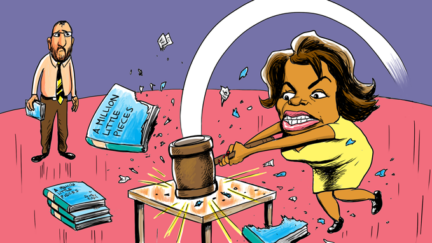
A Million Little Pieces
James Frey’s popular memoir stirred controversy and media attention after it was revealed to contain numerous exaggerations and fabrications.
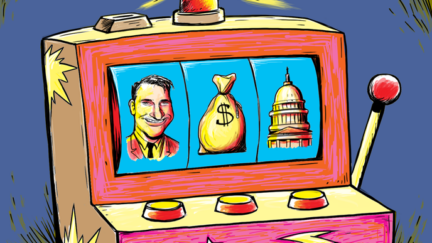
Abramoff: Lobbying Congress
Super-lobbyist Abramoff was caught in a scheme to lobby against his own clients. Was a corrupt individual or a corrupt system – or both – to blame?
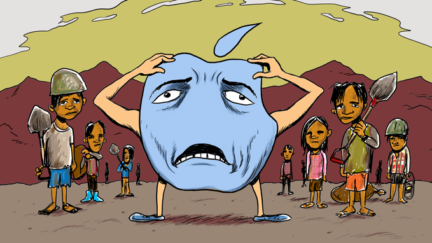
Apple Suppliers & Labor Practices
Is tech company Apple, Inc. ethically obligated to oversee the questionable working conditions of other companies further down their supply chain?
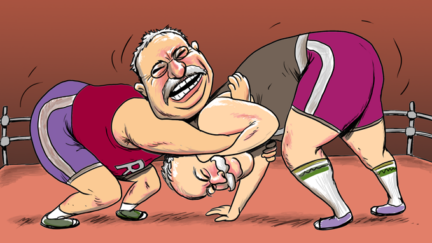
Approaching the Presidency: Roosevelt & Taft
Some presidents view their responsibilities in strictly legal terms, others according to duty. Roosevelt and Taft took two extreme approaches.
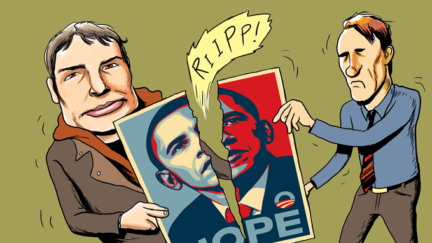
Appropriating “Hope”
Fairey’s portrait of Barack Obama raised debate over the extent to which an artist can use and modify another’s artistic work, yet still call it one’s own.

Arctic Offshore Drilling
Competing groups frame the debate over oil drilling off Alaska’s coast in varying ways depending on their environmental and economic interests.

Banning Burkas: Freedom or Discrimination?
The French law banning women from wearing burkas in public sparked debate about discrimination and freedom of religion.
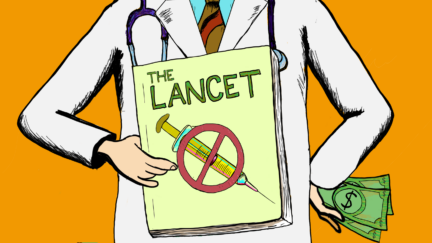
Birthing Vaccine Skepticism
Wakefield published an article riddled with inaccuracies and conflicts of interest that created significant vaccine hesitancy regarding the MMR vaccine.
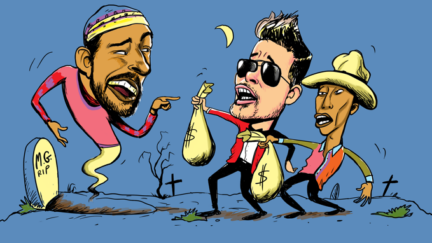
Blurred Lines of Copyright
Marvin Gaye’s Estate won a lawsuit against Robin Thicke and Pharrell Williams for the hit song “Blurred Lines,” which had a similar feel to one of his songs.
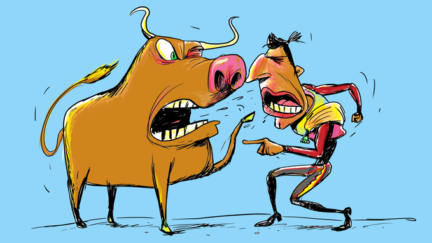
Bullfighting: Art or Not?
Bullfighting has been a prominent cultural and artistic event for centuries, but in recent decades it has faced increasing criticism for animal rights’ abuse.

Buying Green: Consumer Behavior
Do purchasing green products, such as organic foods and electric cars, give consumers the moral license to indulge in unethical behavior?

Cadavers in Car Safety Research
Engineers at Heidelberg University insist that the use of human cadavers in car safety research is ethical because their research can save lives.
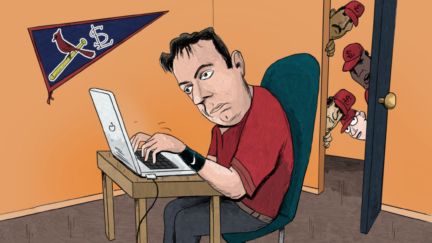

Cardinals’ Computer Hacking
St. Louis Cardinals scouting director Chris Correa hacked into the Houston Astros’ webmail system, leading to legal repercussions and a lifetime ban from MLB.
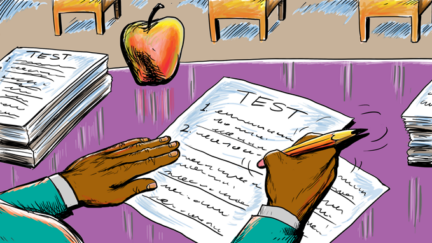
Cheating: Atlanta’s School Scandal
Teachers and administrators at Parks Middle School adjust struggling students’ test scores in an effort to save their school from closure.
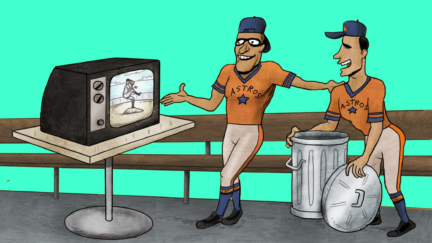
Cheating: Sign-Stealing in MLB
The Houston Astros’ sign-stealing scheme rocked the baseball world, leading to a game-changing MLB investigation and fallout.
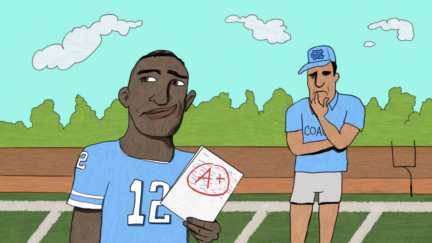
Cheating: UNC’s Academic Fraud
UNC’s academic fraud scandal uncovered an 18-year scheme of unchecked coursework and fraudulent classes that enabled student-athletes to play sports.
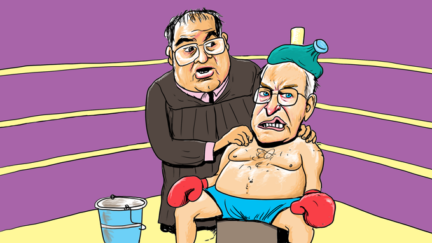
Cheney v. U.S. District Court
A controversial case focuses on Justice Scalia’s personal friendship with Vice President Cheney and the possible conflict of interest it poses to the case.
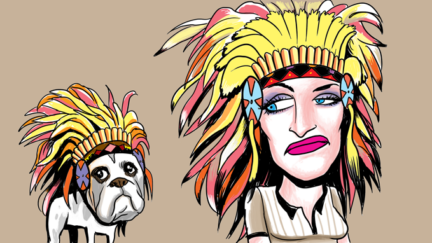
Christina Fallin: “Appropriate Culturation?”
After Fallin posted a picture of herself wearing a Plain’s headdress on social media, uproar emerged over cultural appropriation and Fallin’s intentions.

Climate Change & the Paris Deal
While climate change poses many abstract problems, the actions (or inactions) of today’s populations will have tangible effects on future generations.
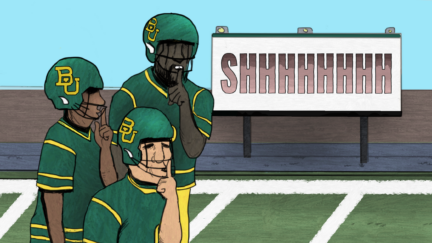
Cover-Up on Campus
While the Baylor University football team was winning on the field, university officials failed to take action when allegations of sexual assault by student athletes emerged.

Covering Female Athletes
Sports Illustrated stirs controversy when their cover photo of an Olympic skier seems to focus more on her physical appearance than her athletic abilities.
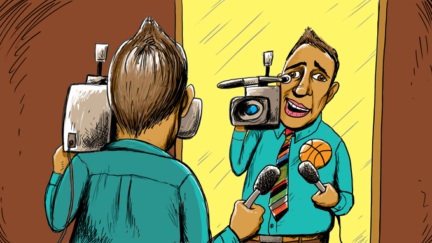
Covering Yourself? Journalists and the Bowl Championship
Can news outlets covering the Bowl Championship Series fairly report sports news if their own polls were used to create the news?
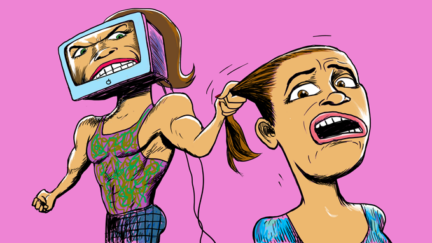
Cyber Harassment
After a student defames a middle school teacher on social media, the teacher confronts the student in class and posts a video of the confrontation online.

Defending Freedom of Tweets?
Running back Rashard Mendenhall receives backlash from fans after criticizing the celebration of the assassination of Osama Bin Laden in a tweet.

Dennis Kozlowski: Living Large
Dennis Kozlowski was an effective leader for Tyco in his first few years as CEO, but eventually faced criminal charges over his use of company assets.
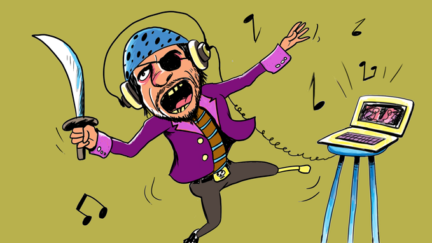
Digital Downloads
File-sharing program Napster sparked debate over the legal and ethical dimensions of downloading unauthorized copies of copyrighted music.

Dr. V’s Magical Putter
Journalist Caleb Hannan outed Dr. V as a trans woman, sparking debate over the ethics of Hannan’s reporting, as well its role in Dr. V’s suicide.
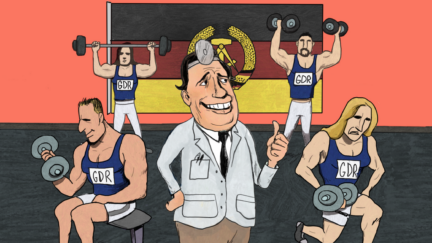
East Germany’s Doping Machine
From 1968 to the late 1980s, East Germany (GDR) doped some 9,000 athletes to gain success in international athletic competitions despite being aware of the unfortunate side effects.
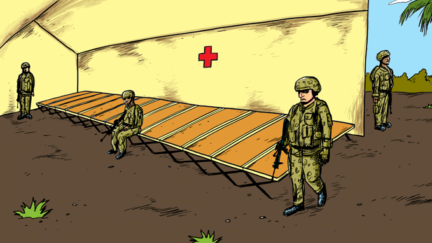
Ebola & American Intervention
Did the dispatch of U.S. military units to Liberia to aid in humanitarian relief during the Ebola epidemic help or hinder the process?
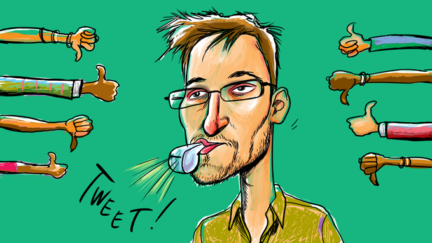
Edward Snowden: Traitor or Hero?
Was Edward Snowden’s release of confidential government documents ethically justifiable?
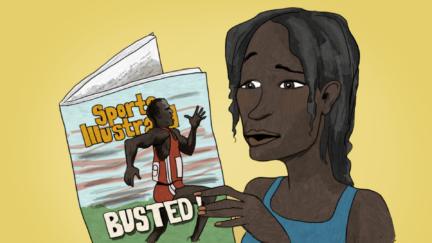
Ethical Pitfalls in Action
Why do good people do bad things? Behavioral ethics is the science of moral decision-making, which explores why and how people make the ethical (and unethical) decisions that they do.

Ethical Use of Home DNA Testing
The rising popularity of at-home DNA testing kits raises questions about privacy and consumer rights.

Flying the Confederate Flag
A heated debate ensues over whether or not the Confederate flag should be removed from the South Carolina State House grounds.
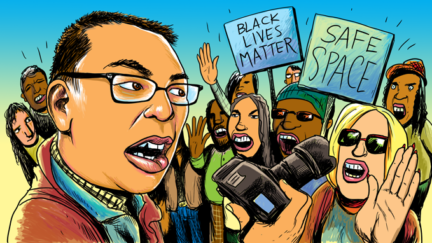
Freedom of Speech on Campus
In the wake of racially motivated offenses, student protests sparked debate over the roles of free speech, deliberation, and tolerance on campus.

Freedom vs. Duty in Clinical Social Work
What should social workers do when their personal values come in conflict with the clients they are meant to serve?
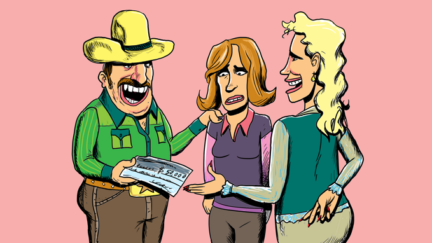
Full Disclosure: Manipulating Donors
When an intern witnesses a donor making a large gift to a non-profit organization under misleading circumstances, she struggles with what to do.
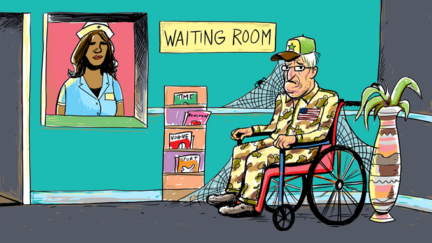
Gaming the System: The VA Scandal
The Veterans Administration’s incentives were meant to spur more efficient and productive healthcare, but not all administrators complied as intended.

German Police Battalion 101
During the Holocaust, ordinary Germans became willing killers even though they could have opted out from murdering their Jewish neighbors.
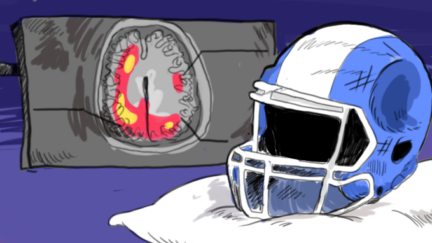
Head Injuries & American Football
Many studies have linked traumatic brain injuries and related conditions to American football, creating controversy around the safety of the sport.

Head Injuries & the NFL
American football is a rough and dangerous game and its impact on the players’ brain health has sparked a hotly contested debate.

Healthcare Obligations: Personal vs. Institutional
A medical doctor must make a difficult decision when informing patients of the effectiveness of flu shots while upholding institutional recommendations.

High Stakes Testing
In the wake of the No Child Left Behind Act, parents, teachers, and school administrators take different positions on how to assess student achievement.
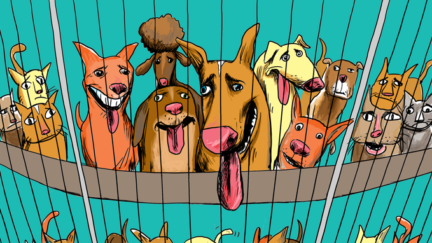
In-FUR-mercials: Advertising & Adoption
When the Lied Animal Shelter faces a spike in animal intake, an advertising agency uses its moral imagination to increase pet adoptions.
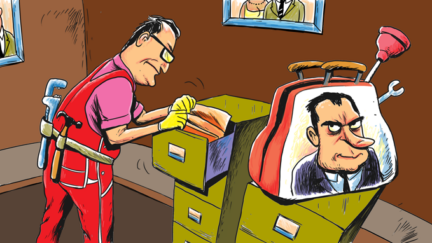
Krogh & the Watergate Scandal
Egil Krogh was a young lawyer working for the Nixon Administration whose ethics faded from view when asked to play a part in the Watergate break-in.
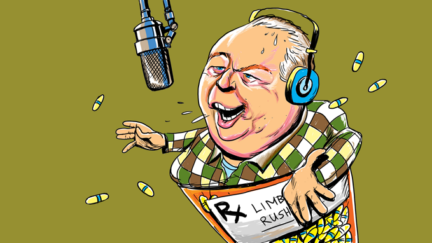
Limbaugh on Drug Addiction
Radio talk show host Rush Limbaugh argued that drug abuse was a choice, not a disease. He later became addicted to painkillers.
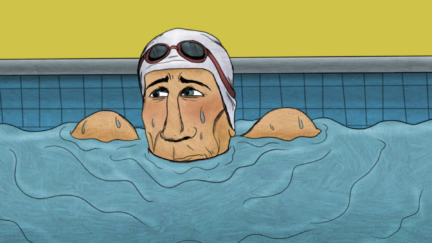
U.S. Olympic swimmer Ryan Lochte’s “over-exaggeration” of an incident at the 2016 Rio Olympics led to very real consequences.
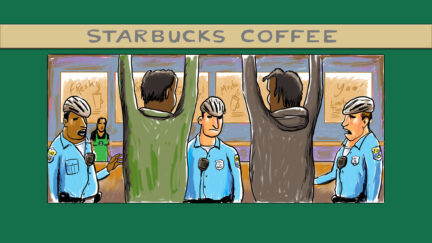
Meet Me at Starbucks
Two black men were arrested after an employee called the police on them, prompting Starbucks to implement “racial-bias” training across all its stores.
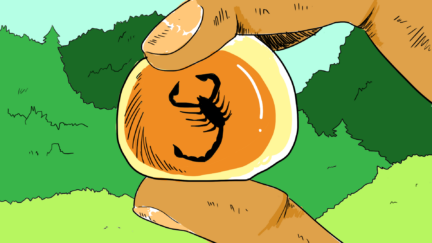
Myanmar Amber
Buying amber could potentially fund an ethnic civil war, but refraining allows collectors to acquire important specimens that could be used for research.

Negotiating Bankruptcy
Bankruptcy lawyer Gellene successfully represented a mining company during a major reorganization, but failed to disclose potential conflicts of interest.

Pao & Gender Bias
Ellen Pao stirred debate in the venture capital and tech industries when she filed a lawsuit against her employer on grounds of gender discrimination.

Pardoning Nixon
One month after Richard Nixon resigned from the presidency, Gerald Ford made the controversial decision to issue Nixon a full pardon.

Patient Autonomy & Informed Consent
Nursing staff and family members struggle with informed consent when taking care of a patient who has been deemed legally incompetent.
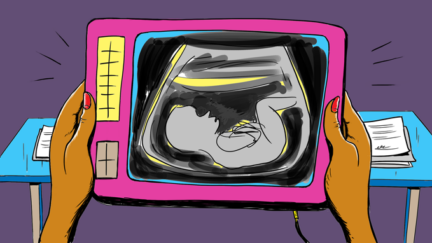
Prenatal Diagnosis & Parental Choice
Debate has emerged over the ethics of prenatal diagnosis and reproductive freedom in instances where testing has revealed genetic abnormalities.
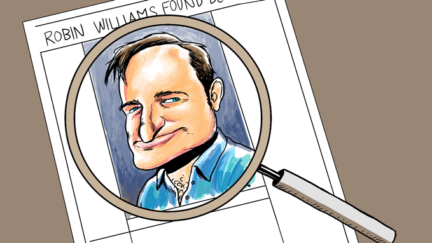
Reporting on Robin Williams
After Robin Williams took his own life, news media covered the story in great detail, leading many to argue that such reporting violated the family’s privacy.

Responding to Child Migration
An influx of children migrants posed logistical and ethical dilemmas for U.S. authorities while intensifying ongoing debate about immigration.
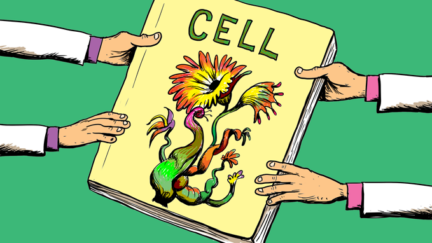
Retracting Research: The Case of Chandok v. Klessig
A researcher makes the difficult decision to retract a published, peer-reviewed article after the original research results cannot be reproduced.

Sacking Social Media in College Sports
In the wake of questionable social media use by college athletes, the head coach at University of South Carolina bans his players from using Twitter.
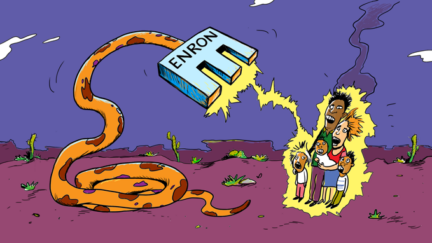
Selling Enron
Following the deregulation of electricity markets in California, private energy company Enron profited greatly, but at a dire cost.
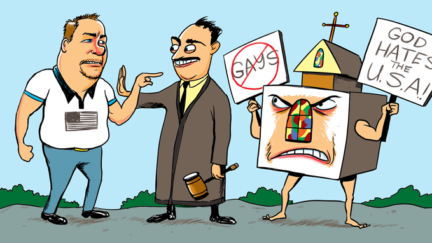
Snyder v. Phelps
Freedom of speech was put on trial in a case involving the Westboro Baptist Church and their protesting at the funeral of U.S. Marine Matthew Snyder.
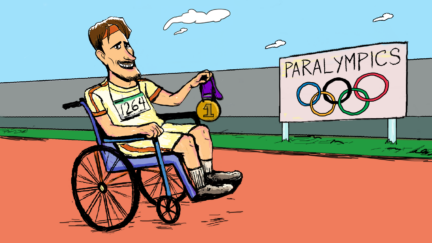
Something Fishy at the Paralympics
Rampant cheating has plagued the Paralympics over the years, compromising the credibility and sportsmanship of Paralympian athletes.

Sports Blogs: The Wild West of Sports Journalism?
Deadspin pays an anonymous source for information related to NFL star Brett Favre, sparking debate over the ethics of “checkbook journalism.”
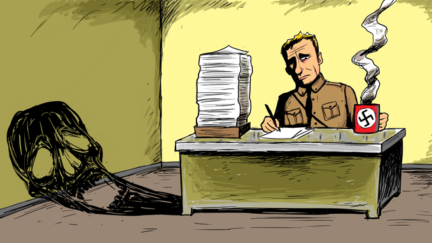
Stangl & the Holocaust
Franz Stangl was the most effective Nazi administrator in Poland, killing nearly one million Jews at Treblinka, but he claimed he was simply following orders.
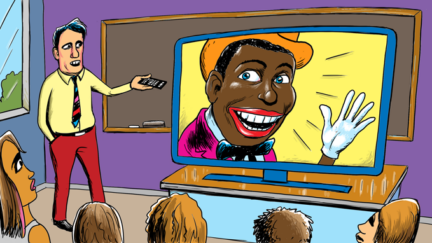
Teaching Blackface: A Lesson on Stereotypes
A teacher was put on leave for showing a blackface video during a lesson on racial segregation, sparking discussion over how to teach about stereotypes.
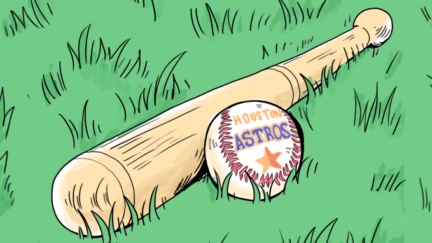
The Astros’ Sign-Stealing Scandal
The Houston Astros rode a wave of success, culminating in a World Series win, but it all came crashing down when their sign-stealing scheme was revealed.
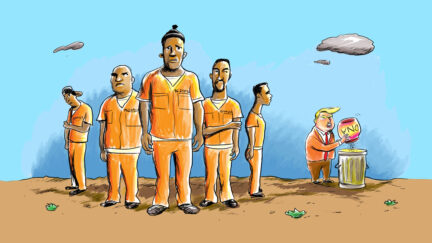
The Central Park Five
Despite the indisputable and overwhelming evidence of the innocence of the Central Park Five, some involved in the case refuse to believe it.

The CIA Leak
Legal and political fallout follows from the leak of classified information that led to the identification of CIA agent Valerie Plame.
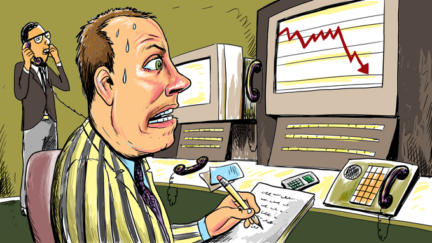
The Collapse of Barings Bank
When faced with growing losses, investment banker Nick Leeson took big risks in an attempt to get out from under the losses. He lost.
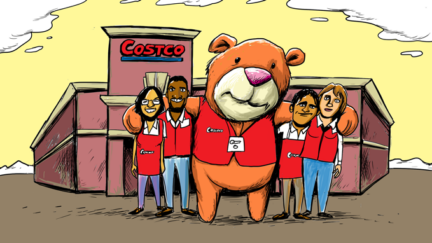
The Costco Model
How can companies promote positive treatment of employees and benefit from leading with the best practices? Costco offers a model.
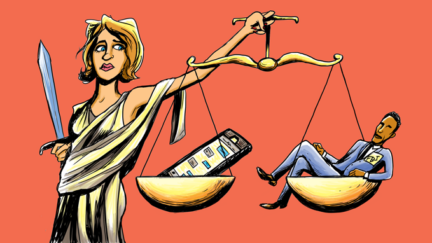
The FBI & Apple Security vs. Privacy
How can tech companies and government organizations strike a balance between maintaining national security and protecting user privacy?
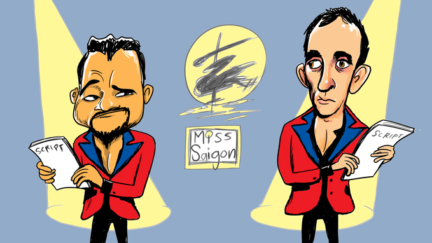
The Miss Saigon Controversy
When a white actor was cast for the half-French, half-Vietnamese character in the Broadway production of Miss Saigon , debate ensued.

The Sandusky Scandal
Following the conviction of assistant coach Jerry Sandusky for sexual abuse, debate continues on how much university officials and head coach Joe Paterno knew of the crimes.

The Varsity Blues Scandal
A college admissions prep advisor told wealthy parents that while there were front doors into universities and back doors, he had created a side door that was worth exploring.
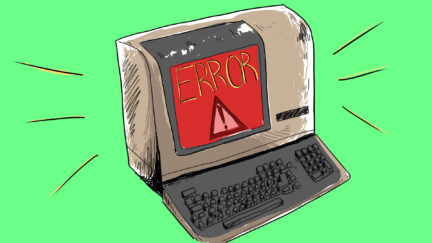
Providing radiation therapy to cancer patients, Therac-25 had malfunctions that resulted in 6 deaths. Who is accountable when technology causes harm?

Welfare Reform
The Welfare Reform Act changed how welfare operated, intensifying debate over the government’s role in supporting the poor through direct aid.

Wells Fargo and Moral Emotions
In a settlement with regulators, Wells Fargo Bank admitted that it had created as many as two million accounts for customers without their permission.
Stay Informed
Support our work.
Help | Advanced Search
Computer Science > Artificial Intelligence
Title: exploring and steering the moral compass of large language models.
Abstract: Large Language Models (LLMs) have become central to advancing automation and decision-making across various sectors, raising significant ethical questions. This study proposes a comprehensive comparative analysis of the most advanced LLMs to assess their moral profiles. We subjected several state-of-the-art models to a selection of ethical dilemmas and found that all the proprietary ones are mostly utilitarian and all of the open-weights ones align mostly with values-based ethics. Furthermore, when using the Moral Foundations Questionnaire, all models we probed - except for Llama 2- displayed a strong liberal bias. Lastly, in order to causally intervene in one of the studied models, we propose a novel similarity-specific activation steering technique. Using this method, we were able to reliably steer the model's moral compass to different ethical schools. All of these results showcase that there is an ethical dimension in already deployed LLMs, an aspect that is generally overlooked.
Submission history
Access paper:.
- HTML (experimental)
- Other Formats
References & Citations
- Google Scholar
- Semantic Scholar
BibTeX formatted citation
Bibliographic and Citation Tools
Code, data and media associated with this article, recommenders and search tools.
- Institution
arXivLabs: experimental projects with community collaborators
arXivLabs is a framework that allows collaborators to develop and share new arXiv features directly on our website.
Both individuals and organizations that work with arXivLabs have embraced and accepted our values of openness, community, excellence, and user data privacy. arXiv is committed to these values and only works with partners that adhere to them.
Have an idea for a project that will add value for arXiv's community? Learn more about arXivLabs .

IMAGES
VIDEO
COMMENTS
The assignment aims to help you apply the steps of an ethical decision-making model and understand how the six moral principles influence ethical decision-making. INSTRUCTIONS. Your paper must be in current APA format including title page and reference page. The body of your paper must be 6-9 pages and include at least 6 references.
If it is a complex ethical dilemma, then you should take time to thoroughly analyze and assess all aspects of the situation and its potential solutions. 3. Determine the nature and dimensions of the dilemma. There are a few steps to follow to ensure that you have examined the problem in all of its various dimensions:
This guide is intended to provide advice for students writing the papers in Ethical Reasoning 15. Most of the paper assignments for the course can be approached flexibly and creatively — there is no single recipe for writing successful papers in the course. But the paper assignments do involve a few common intellectual tasks
Ethics Resources. A Framework for Ethical Decision Making. This document is designed as an introduction to thinking ethically. Read more about what the framework can (and cannot) do. We all have an image of our better selves—of how we are when we act ethically or are "at our best.". We probably also have an image of what an ethical ...
A rudimentary framework for how managers engage in the decision making process contains four steps. 1) Identify the problem. 2) Generate alternatives. 3) Decide on a course of action. 4) Implement. There are several ways that a manager can use this framework to make decisions - intuition, analysis, democratic process, etc.
The Markkula Center's Ethical Decision-Making Framework is a tool designed to 1) help users see and identify a broader set of ethical issues than they would have without it, and 2) guide users through a process that includes both pre-decision and post-decision steps. The goal of the Framework is to help people make better informed, more ...
Although ethical decision making has long been recognized as critical for organizations (Trevino, Reference Trevino 1986), its importance in the 21 st century continues to gain recognition in both the academic literature and the popular press due to emerging ethical issues. In academics, there is a growing effort to promote open science (Nosek et al., Reference Nosek, Alter, Banks, Borsboom ...
An ethics paper is a type of an argumentative assignment that deals with a certain ethical problem that a student has to describe and solve. Also, it can be an essay where a certain controversial event or concept is elaborated through an ethical lens (e.g. moral rules and principles), or a certain ethical dilemma is explained.
Action explanation. Articulates an explicit, convincing, and reasoned ethical position on issues. Incorporates institutional core values, professional guidelines, and societal laws in decision-making. Takes ownership for position / decision / action.
D. To apply the steps of the ethical decision making model to your chosen scenario, divide the body of your paper—formatted in current APA style—into the steps outlined in the "A Practitioner's Guide to Ethical Decision Making" document, and outlined below, making sure to address all questions for each section: Identify the problem(s). ). In this section make sure to: o Outline the ...
1971; Rest, 1989). The most popular model of ethical decision making championed by the reasonists. involves four mental steps: 1) awareness, 2) intention, 3) judgment, and 4) behavior. For a ...
The ANA's Code of Ethics for Nurses with Interpretive Statements is an ethical standard that guides nursing practice and ethical decision-making. This section will review several basic ethical concepts related to the ANA's Ethics Standard of Professional Performance, such as values, morals, ethical theories, ethical principles, and the ANA ...
ASSIGNMENT #1 - Ethical Dilemma Case Assignment1 This assignment offers you the opportunity to explore the ethical decision-making process introduced in the seminar and apply the steps to a current ethical dilemma that you are facing. INSTRUCTIONS Deadline: Your assignment must be uploaded to Canvas by 11:59pm the night before our third
CHPL 615 ETHICAL DECISION MAKING PAPER WEEK THREE IV.docx. CHPL 615 ETHICAL DECISION-MAKING MODEL ASSIGNMENT INSTRUCTIONS OVERVIEW The focus of this paper is the integration of acquired knowledge to develop an ethical decisionmaking process/model for use in making biblically informed decisions in your personal mi.
ETHICAL DECISION MAKING: THE USS THEODORE ROOSEVELT 3 testing, the way the virus manifests, infected individuals tested negative during the incubation period (Gafni & Garofoli, 2020). 2. Judgment against ethical criteria. The captain had to judge whether it was more ethical to follow the Navy protocol directing all communication to his commanding officer who was on the ship, or bypas him and ...
More than 70 cases pair ethics concepts with real world situations. From journalism, performing arts, and scientific research to sports, law, and business, these case studies explore current and historic ethical dilemmas, their motivating biases, and their consequences. Each case includes discussion questions, related videos, and a bibliography.
For this assignment, pay specific attention to steps 1-4 of the ethical decision-making model as this will become the headings for your paper as outlined in step 4 below. Step into the shoes of the counselor (as though you are the counselor in the scenario you watched). Step 3: Read, the remaining assignment instructions in its entirety.
Large Language Models (LLMs) have become central to advancing automation and decision-making across various sectors, raising significant ethical questions. This study proposes a comprehensive comparative analysis of the most advanced LLMs to assess their moral profiles. We subjected several state-of-the-art models to a selection of ethical dilemmas and found that all the proprietary ones are ...